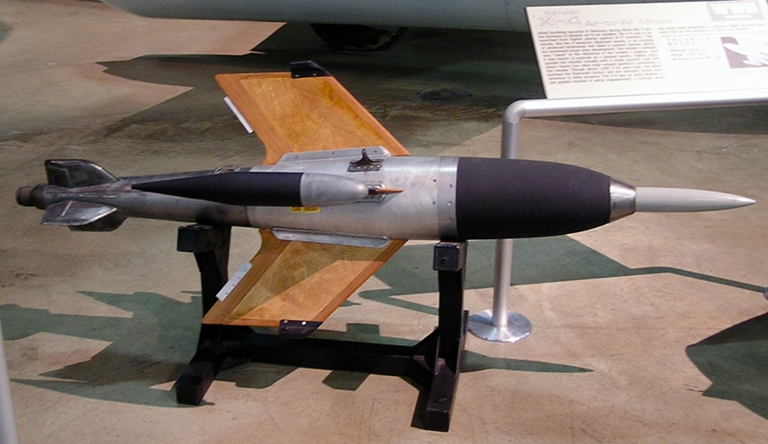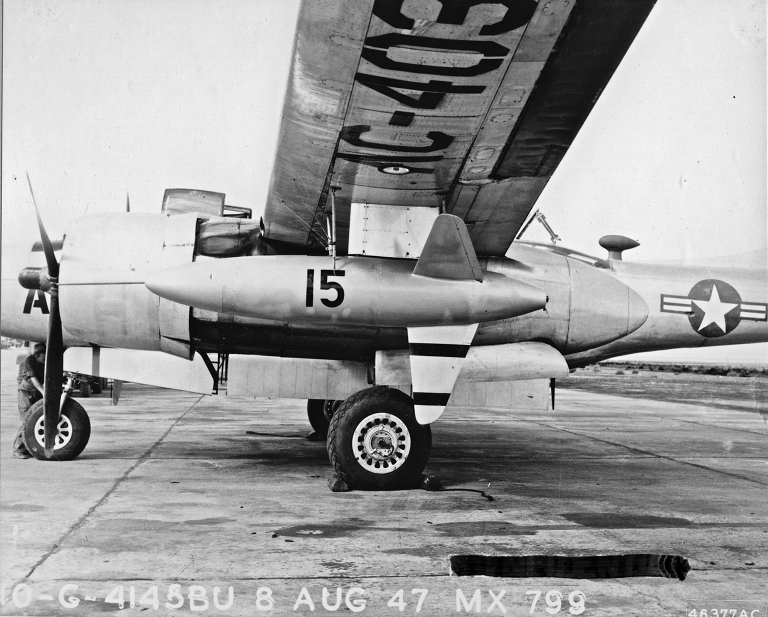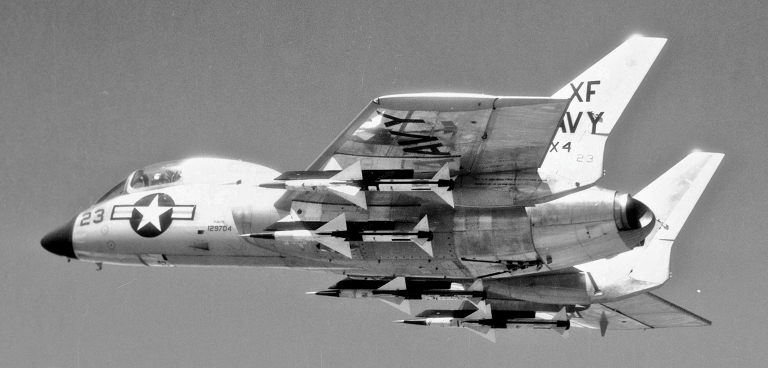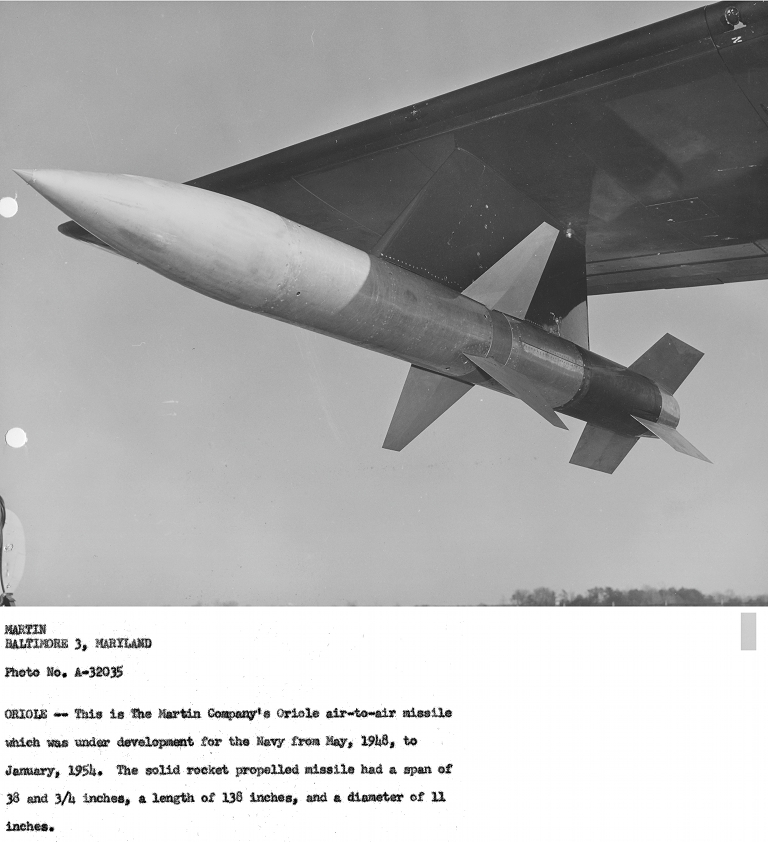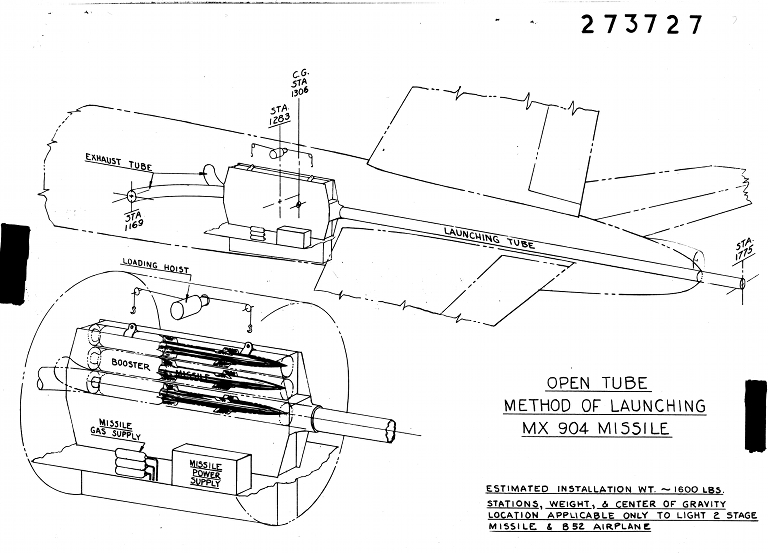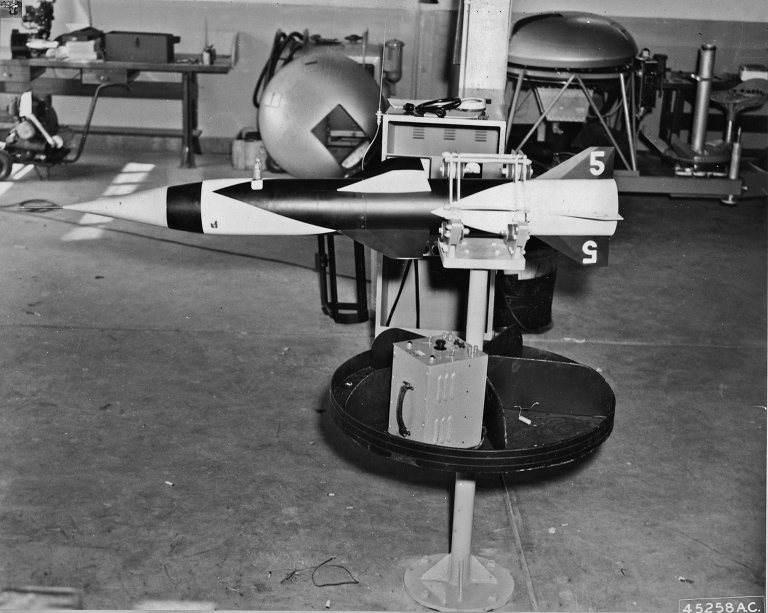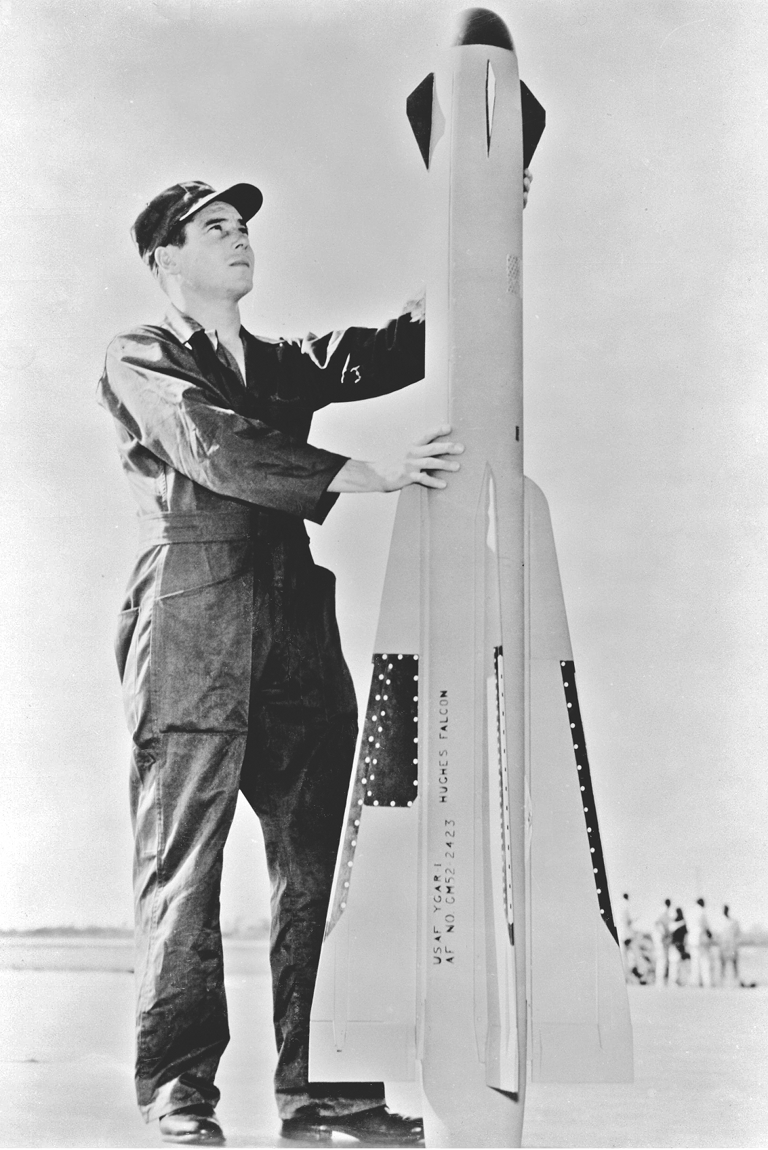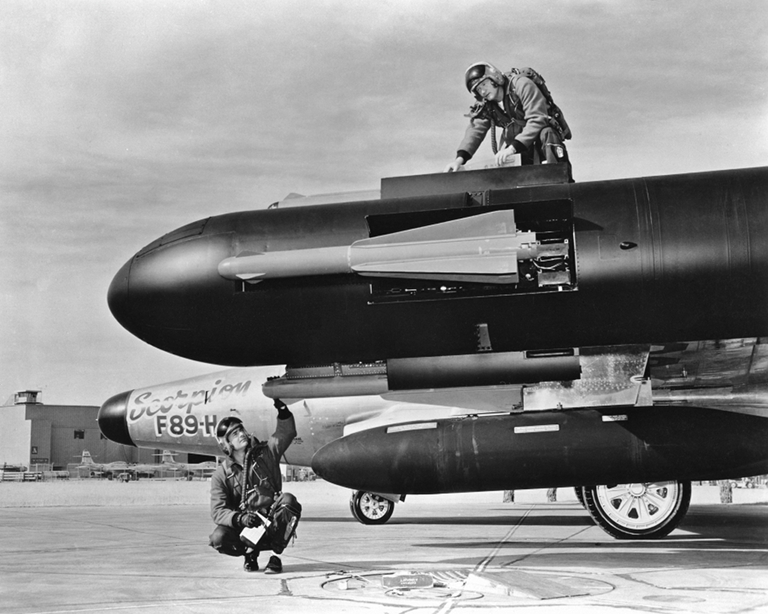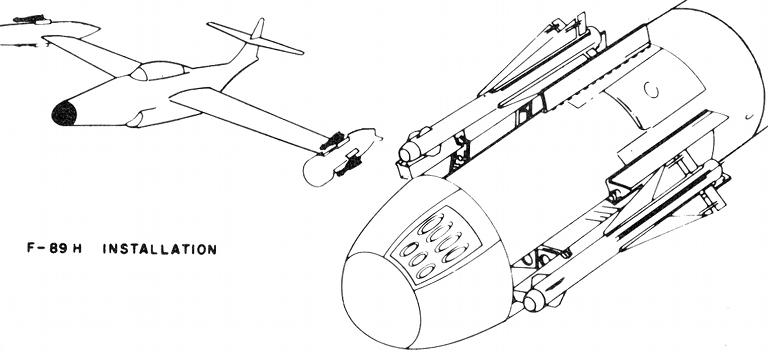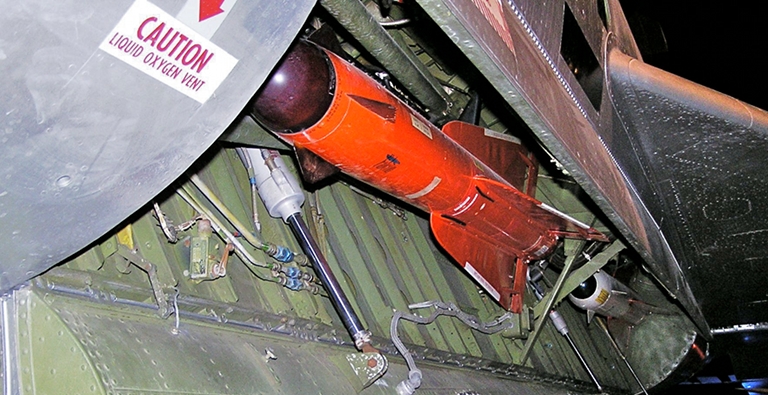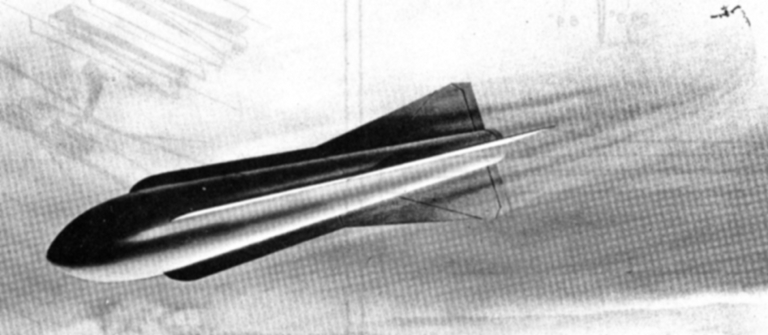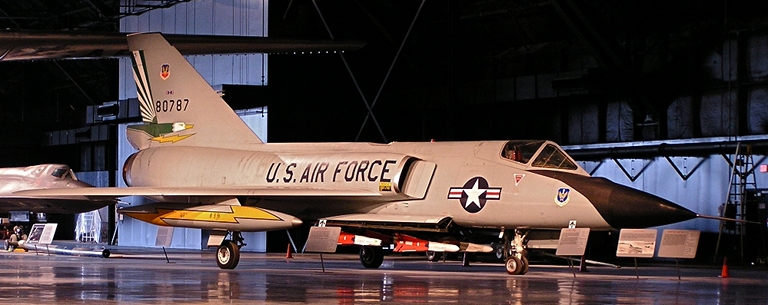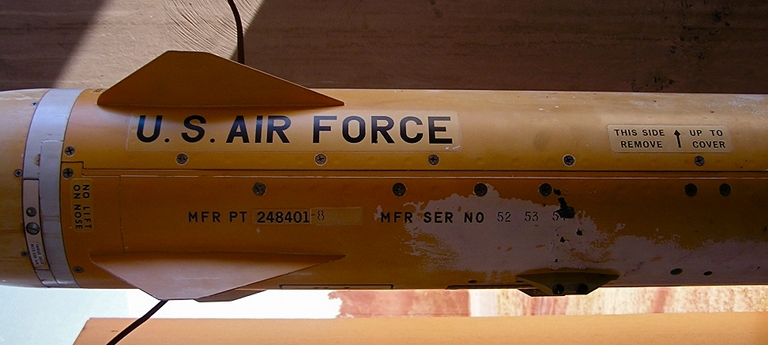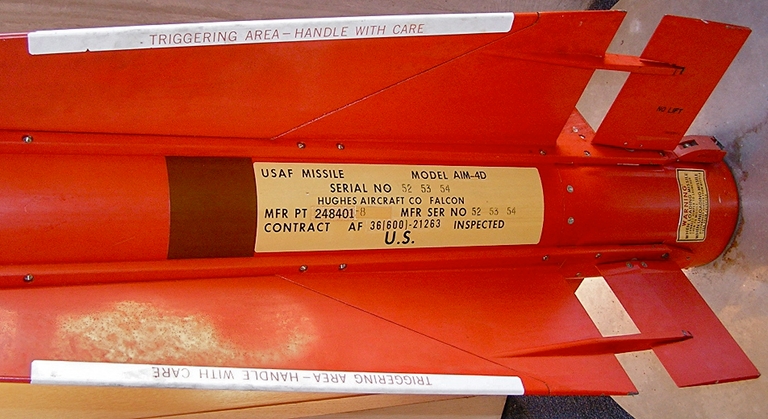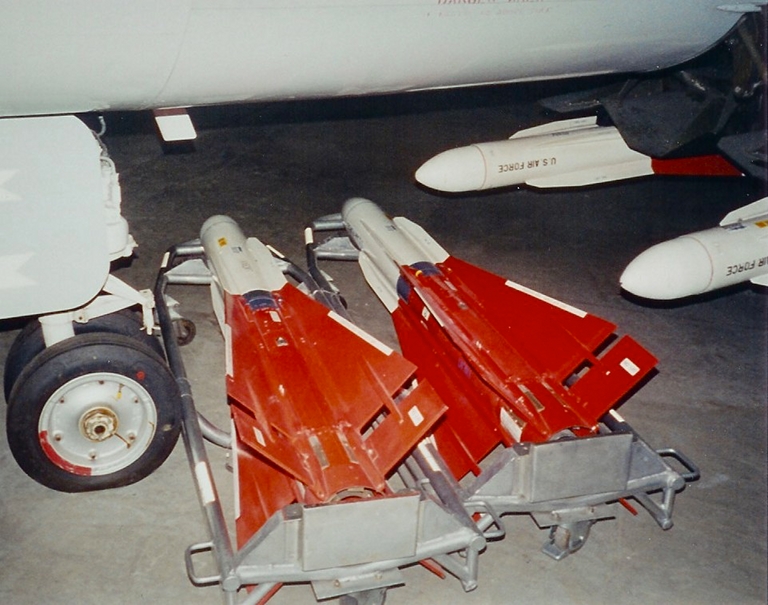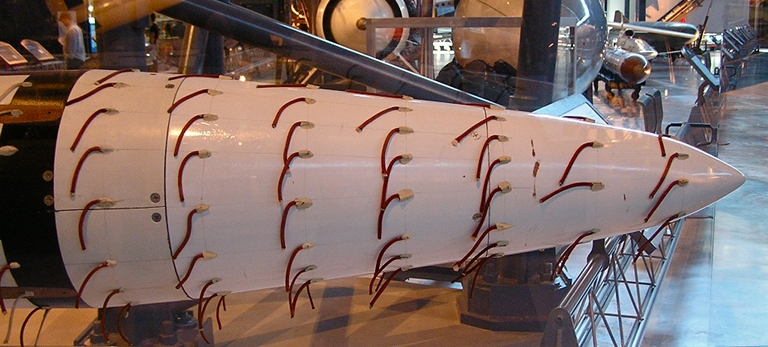|
||||||||||||||||||||||
![Home - Air Power Australia Website [Click for more ...]](APA/APA-Title-Main.png) |
||||||||||||||||||||||
![Sukhoi PAK-FA and Flanker Index Page [Click for more ...]](APA/flanker.png) |
![F-35 Joint Strike Fighter Index Page [Click for more ...]](APA/jsf.png) |
![Weapons Technology Index Page [Click for more ...]](APA/weps.png) |
![News and Media Related Material Index Page [Click for more ...]](APA/media.png) |
|||||||||||||||||||
![Surface to Air Missile Systems / Integrated Air Defence Systems Index Page [Click for more ...]](APA/sams-iads.png) |
![Ballistic Missiles and Missile Defence Page [Click for more ...]](APA/msls-bmd.png) |
![Air Power and National Military Strategy Index Page [Click for more ...]](APA/strategy.png) |
![Military Aviation Historical Topics Index Page [Click for more ...]](APA/history.png)
|
![Intelligence, Surveillance and Reconnaissance and Network Centric Warfare Index Page [Click for more ...]](APA/isr-ncw.png) |
![Information Warfare / Operations and Electronic Warfare Index Page [Click for more ...]](APA/iw.png) |
![Systems and Basic Technology Index Page [Click for more ...]](APA/technology.png) |
![Related Links Index Page [Click for more ...]](APA/links.png) |
|||||||||||||||
![Homepage of Australia's First Online Journal Covering Air Power Issues (ISSN 1832-2433) [Click for more ...]](APA/apa-analyses.png) |
||||||||||||||||||||||
| Last Updated: Mon Jan 27 11:18:09 UTC 2014 | ||||||||||||||||||||||
|
||||||||||||||||||||||
|
Arming
America’s
Interceptors:
The Hughes Falcon Missile Family Technical Report APA-TR-2011-0601 |
||||||||||||||||||||||||||||||||||||||||||||||||||||||||||||||||||||||||||||||||||||||||||||||||||||||||||||||||||||||||||||||||||||||||||||||||||||||||||||||||||||||||||||||||||||||||||||||||||||||||||||||||||||||||||||||||||||||||||||||||||||||||||||||||||||||||||||||||||||||||||||||||||||||||||||||||||||||||||||||||||||||||||||||||||||||||||||||||||||||||||||||||||||||||||||||||||||||||||||||||||||||||||||||||||||||||||||||||||||||||||||||||||||||||||||||||||||||||||||||||||||||||||||||||||||||||||||||||||||||||||||||||||||||||||||||||||||||||||||||||||||||||||||||||||||||||||||||||||||||||||||||||||||||||||||||||||||||||||||||||||||||||||||||||||||||||||||||||||||||||||||||||||||||||||||||||||||||||||||||
| by
Sean
O'Connor,
BA,
MS
(AMU) June, 2011 Updated July, 2011 Updated April, 2012 Text © 2011 Sean O'Connor Layout © 2011 Carlo Kopp |
||||||||||||||||||||||||||||||||||||||||||||||||||||||||||||||||||||||||||||||||||||||||||||||||||||||||||||||||||||||||||||||||||||||||||||||||||||||||||||||||||||||||||||||||||||||||||||||||||||||||||||||||||||||||||||||||||||||||||||||||||||||||||||||||||||||||||||||||||||||||||||||||||||||||||||||||||||||||||||||||||||||||||||||||||||||||||||||||||||||||||||||||||||||||||||||||||||||||||||||||||||||||||||||||||||||||||||||||||||||||||||||||||||||||||||||||||||||||||||||||||||||||||||||||||||||||||||||||||||||||||||||||||||||||||||||||||||||||||||||||||||||||||||||||||||||||||||||||||||||||||||||||||||||||||||||||||||||||||||||||||||||||||||||||||||||||||||||||||||||||||||||||||||||||||||||||||||||||||||||
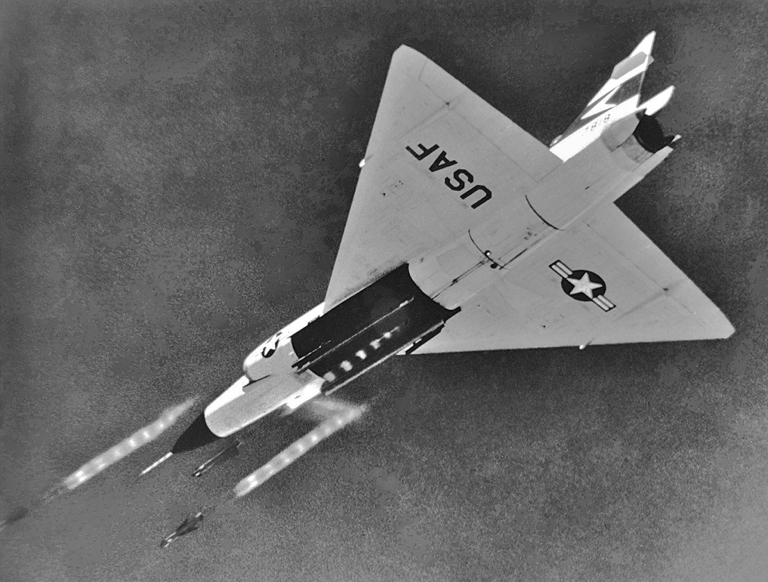 An F-102A launches three GAR-1
Falcon missiles (USAF via Robert Sullivan).
|
||||||||||||||||||||||||||||||||||||||||||||||||||||||||||||||||||||||||||||||||||||||||||||||||||||||||||||||||||||||||||||||||||||||||||||||||||||||||||||||||||||||||||||||||||||||||||||||||||||||||||||||||||||||||||||||||||||||||||||||||||||||||||||||||||||||||||||||||||||||||||||||||||||||||||||||||||||||||||||||||||||||||||||||||||||||||||||||||||||||||||||||||||||||||||||||||||||||||||||||||||||||||||||||||||||||||||||||||||||||||||||||||||||||||||||||||||||||||||||||||||||||||||||||||||||||||||||||||||||||||||||||||||||||||||||||||||||||||||||||||||||||||||||||||||||||||||||||||||||||||||||||||||||||||||||||||||||||||||||||||||||||||||||||||||||||||||||||||||||||||||||||||||||||||||||||||||||||||||||||
|
|
||||||||||||||||||||||||||||||||||||||||||||||||||||||||||||||||||||||||||||||||||||||||||||||||||||||||||||||||||||||||||||||||||||||||||||||||||||||||||||||||||||||||||||||||||||||||||||||||||||||||||||||||||||||||||||||||||||||||||||||||||||||||||||||||||||||||||||||||||||||||||||||||||||||||||||||||||||||||||||||||||||||||||||||||||||||||||||||||||||||||||||||||||||||||||||||||||||||||||||||||||||||||||||||||||||||||||||||||||||||||||||||||||||||||||||||||||||||||||||||||||||||||||||||||||||||||||||||||||||||||||||||||||||||||||||||||||||||||||||||||||||||||||||||||||||||||||||||||||||||||||||||||||||||||||||||||||||||||||||||||||||||||||||||||||||||||||||||||||||||||||||||||||||||||||||||||||||||||||||||
|
||||||||||||||||||||||||||||||||||||||||||||||||||||||||||||||||||||||||||||||||||||||||||||||||||||||||||||||||||||||||||||||||||||||||||||||||||||||||||||||||||||||||||||||||||||||||||||||||||||||||||||||||||||||||||||||||||||||||||||||||||||||||||||||||||||||||||||||||||||||||||||||||||||||||||||||||||||||||||||||||||||||||||||||||||||||||||||||||||||||||||||||||||||||||||||||||||||||||||||||||||||||||||||||||||||||||||||||||||||||||||||||||||||||||||||||||||||||||||||||||||||||||||||||||||||||||||||||||||||||||||||||||||||||||||||||||||||||||||||||||||||||||||||||||||||||||||||||||||||||||||||||||||||||||||||||||||||||||||||||||||||||||||||||||||||||||||||||||||||||||||||||||||||||||||||||||||||||||||||||
I. Introduction |
||||||||||||||||||||||||||||||||||||||||||||||||||||||||||||||||||||||||||||||||||||||||||||||||||||||||||||||||||||||||||||||||||||||||||||||||||||||||||||||||||||||||||||||||||||||||||||||||||||||||||||||||||||||||||||||||||||||||||||||||||||||||||||||||||||||||||||||||||||||||||||||||||||||||||||||||||||||||||||||||||||||||||||||||||||||||||||||||||||||||||||||||||||||||||||||||||||||||||||||||||||||||||||||||||||||||||||||||||||||||||||||||||||||||||||||||||||||||||||||||||||||||||||||||||||||||||||||||||||||||||||||||||||||||||||||||||||||||||||||||||||||||||||||||||||||||||||||||||||||||||||||||||||||||||||||||||||||||||||||||||||||||||||||||||||||||||||||||||||||||||||||||||||||||||||||||||||||||||||||
The development
of the air-to-air
missile has seen a long and often tumultuous history. From its first
serious beginnings during World War II to the advanced,
ramjet-powered weapons undergoing testing today, the capability and
effectiveness of the AAM has increased exponentially since the first
pioneering efforts. During the Cold War, the AAM played a key role
in the defense of North America from the threat of Soviet bombers.
Supersonic interceptors entered and exited USAF service at various
times, but all shared one common element: the Falcon missile.
Originally intended as a bomber-carried AAM for defense against
fighter attack, the various Falcon missile variants enjoyed a service
career spanning nearly 50 years, leaving behind a legacy often
forgotten by aviation history.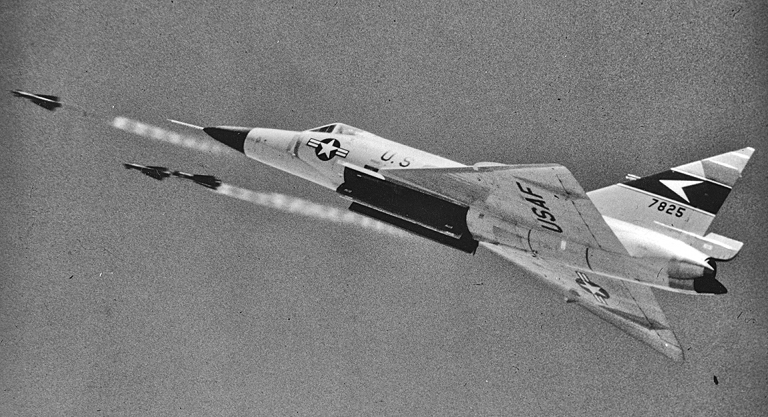 An F-102A launches three GAR-1
Falcon missiles (USAF via Robert Sullivan)
|
||||||||||||||||||||||||||||||||||||||||||||||||||||||||||||||||||||||||||||||||||||||||||||||||||||||||||||||||||||||||||||||||||||||||||||||||||||||||||||||||||||||||||||||||||||||||||||||||||||||||||||||||||||||||||||||||||||||||||||||||||||||||||||||||||||||||||||||||||||||||||||||||||||||||||||||||||||||||||||||||||||||||||||||||||||||||||||||||||||||||||||||||||||||||||||||||||||||||||||||||||||||||||||||||||||||||||||||||||||||||||||||||||||||||||||||||||||||||||||||||||||||||||||||||||||||||||||||||||||||||||||||||||||||||||||||||||||||||||||||||||||||||||||||||||||||||||||||||||||||||||||||||||||||||||||||||||||||||||||||||||||||||||||||||||||||||||||||||||||||||||||||||||||||||||||||||||||||||||||||
II. Early AAM Efforts |
||||||||||||||||||||||||||||||||||||||||||||||||||||||||||||||||||||||||||||||||||||||||||||||||||||||||||||||||||||||||||||||||||||||||||||||||||||||||||||||||||||||||||||||||||||||||||||||||||||||||||||||||||||||||||||||||||||||||||||||||||||||||||||||||||||||||||||||||||||||||||||||||||||||||||||||||||||||||||||||||||||||||||||||||||||||||||||||||||||||||||||||||||||||||||||||||||||||||||||||||||||||||||||||||||||||||||||||||||||||||||||||||||||||||||||||||||||||||||||||||||||||||||||||||||||||||||||||||||||||||||||||||||||||||||||||||||||||||||||||||||||||||||||||||||||||||||||||||||||||||||||||||||||||||||||||||||||||||||||||||||||||||||||||||||||||||||||||||||||||||||||||||||||||||||||||||||||||||||||||
WWII GenesisThe devastating effect of airpower demonstrated in World War II led to the initiation of development programs for four AAMs by 1943. The goal of these early AAM programs was interception of bombers; missile designs did not yet incorporate the necessary maneuverability to make them effective anti-fighter weapons. In Germany, the Henschel Flugzeugwerke Hs.298 and Ruhrstahl X-4 both underwent firing trials by the end of 1944, but neither weapon served in combat. England examined the Artemis missile project in the 1943-1944 timeframe.
Luftwaffe X-4 AAM on display at the USAF Museum (Sean O’Connor) The US Navy began developing the Gorgon AAM in July of 1943. Cdr. D. S. Fahrney first suggested the use of unpiloted aircraft for various roles, including bomber interception, in 1937. The USN attempted to begin development in 1940, but available propulsion systems were not adequate. By 1943, rocket technology had matured to the point where it represented a viable propulsion option, and Gorgon was reborn. Gorgon survived the war as an AAM concept, but found itself relegated to R&D status in the middle of 1946 as more advanced designs were on the drawing board. A fifth AAM program appeared in January of 1944. The USAAF tasked Hughes with developing a subsonic missile capable of intercepting bombers under project MX-570. The resultant missile, designated JB-3 and referred to by Hughes as the Tiamat, conducted its first test launch on 6 August 1945, the same day that Col. Paul Tibbets flew the B-29 Enola Gay to Hiroshima. JB-3 was a large weapon for the time, weighing 625 pounds with a 100-pound warhead. The weapon featured a range of up to nine miles, and employed an early form of SARH guidance. The JB-3 proved to be unsatisfactory in testing, cancellation coming in September of 1946.
A JB-3 AAM underneath the wing of an A-26 Invader (National Archives via Dennis R. Jenkins) While none of the World War II-era programs survived to see operational service, they did provide industry with a technological starting point to develop the first operational AAMs. Work on the JB-3 established Hughes as one of the frontrunners in the AAM development circle, which would serve the company well in the post-war years. Post-War EffortsThe first significant Western AAM program to emerge in the post-war years had its origins in one of the USN’s last major World War II development programs, Project Bumblebee. Because of the success of Japanese kamikaze attacks on the fleet, the USN initiated Project Bumblebee to develop a series of SAM systems. In November of 1945, the USN contracted with MIT to develop the AAM-N-5 Meteor missile as a backstop against the failure of Project Bumblebee. The contract called for the development of both an AAM and a SAM, although only the AAM reached the hardware stage. Meteor began flight trials in July of 1948. While the USN cancelled the program in 1953 in favor of more advanced designs, a recurring theme in early AAM development, it stands as the first AAM ever designed for use by carrier-based aircraft.The USN’s second major post-war AAM program was the AAM-N-2 Sparrow I. Initially, the USN contracted with Sperry in 1946 to develop a beam-riding guidance system for rockets, converting them into crude AAMs. This program morphed into a new AAM with the incorporation of an airframe designed by Douglas capable of containing a larger rocket motor and the necessary guidance equipment. Sparrow I had a protracted development period, with the first intercept occurring in December of 1952. The weapon reached IOC in 1956, but did not remain in use very long. 2,000 missiles were produced, and the weapon had a range of 5 miles.
Four Sparrow I
missiles carried by an F7U-3M (USN via Robert Sullivan) With Sparrow having its genesis in beam-riding rockets, the USN initiated a dedicated AAM program in 1947. A contract was awarded to Martin to develop the AAM-N-4 Oriole missile, with the goal of fielding a weapon employing active radar homing (ARH) to a range of up to 25 miles. Difficulties with the guidance system led to Oriole’s cancellation in 1948, although the airframe returned as a test article in 1950, serving in that status until 1955. The missile appearing as the test article featured a range reduced to 5 miles, indicating that an operational variant would not have met the initial range requirement.
Martin’s AAM-N-4 Oriole (Naval Historical Center via Ryan Crierie) The USAAF cancelled the majority of its AAM programs before production or testing of hardware occurred, primarily due to budgetary constraints. By March of 1947, the MX-570, MX-798, and MX-801 no longer remained active. By July of the same year, the USAAF cancelled the MX-800 and reduced the MX-801 to a guidance system study. The newly formed USAF eliminated the MX-802 and the MX-800 study by March of 1948. The first USAAF AAM to reach the hardware stage was Ryan’s MX-799. The Firebird missile, eventually designated AAM-A-1, employed midcourse command and terminal SARH guidance. An operator directed the missile during midcourse command guidance. Intended for use against bombers, Firebird was subsonic. The first test launch occurred in October of 1947. Earlier in 1947, Ryan initiated studies for a proposed supersonic follow-on program, which lasted until March of 1948.
Firebird test round mounted on an A-26 in December of 1947 (National Archives via Dennis R. Jenkins) F-82 Twin Mustang armed with four Firebird AAMs (National Archives via Dennis R. Jenkins)
EpilogueUltimately, the subsonic speed of the Firebird, coupled with the midcourse command guidance restricting it to daytime, clear-weather use, led to the program’s cancellation in April of 1949. Firebird’s demise, alongside the cancellation of numerous missile projects in the post-war years, left the USAF with a single AAM program.Early AAM CharacteristicsAll dimensions are in inches, weight
figures are in pounds
|
||||||||||||||||||||||||||||||||||||||||||||||||||||||||||||||||||||||||||||||||||||||||||||||||||||||||||||||||||||||||||||||||||||||||||||||||||||||||||||||||||||||||||||||||||||||||||||||||||||||||||||||||||||||||||||||||||||||||||||||||||||||||||||||||||||||||||||||||||||||||||||||||||||||||||||||||||||||||||||||||||||||||||||||||||||||||||||||||||||||||||||||||||||||||||||||||||||||||||||||||||||||||||||||||||||||||||||||||||||||||||||||||||||||||||||||||||||||||||||||||||||||||||||||||||||||||||||||||||||||||||||||||||||||||||||||||||||||||||||||||||||||||||||||||||||||||||||||||||||||||||||||||||||||||||||||||||||||||||||||||||||||||||||||||||||||||||||||||||||||||||||||||||||||||||||||||||||||||||||||
III. The First Falcons |
||||||||||||||||||||||||||||||||||||||||||||||||||||||||||||||||||||||||||||||||||||||||||||||||||||||||||||||||||||||||||||||||||||||||||||||||||||||||||||||||||||||||||||||||||||||||||||||||||||||||||||||||||||||||||||||||||||||||||||||||||||||||||||||||||||||||||||||||||||||||||||||||||||||||||||||||||||||||||||||||||||||||||||||||||||||||||||||||||||||||||||||||||||||||||||||||||||||||||||||||||||||||||||||||||||||||||||||||||||||||||||||||||||||||||||||||||||||||||||||||||||||||||||||||||||||||||||||||||||||||||||||||||||||||||||||||||||||||||||||||||||||||||||||||||||||||||||||||||||||||||||||||||||||||||||||||||||||||||||||||||||||||||||||||||||||||||||||||||||||||||||||||||||||||||||||||||||||||||||||
Birth of the FalconThe genesis of the Falcon missile program stemmed from the Hughes MX-798 study. Upon cancellation in March of 1947, the study was reoriented and restarted as the MX-904. The USAAF now tasked Hughes with the specific goal of developing a bomber-launched AAM, designated AAM-A-2. This lasted until July, when the USAAF downgraded the MX-904 study to guidance system development. The USAF restored the MX-904 missile development program to active status in March of 1948 under the Guided Aircraft Rocket (GAR) program. 1949 illustration depicting MX-904 carriage on the B-52 (National Archives via Dennis R. Jenkins) Early in 1949, the USAF removed the “bomber-launched” classification from the MX-904 program. With Firebird’s cancellation coming in April, the MX-904 stood as the sole USAF AAM program. Hughes nicknamed the MX-904 missile Falcon, the weapon being designated GAR-1. GAR-1The first ground launches of GAR-1 airframes occurred in 1948. Over the course of the GAR-1’s development, Hughes modified the planform of the missile numerous times before arriving at the canard-delta configuration now associated with the Falcon. The original planform featured mid-body wings and tail surfaces. Unusually, the wings and tail surfaces did not lie on the same plane. As the early Falcon concepts were tube-launched, this did not present a problem insofar as mounting the weapon was concerned. Further refinements to this configuration led to an interim airframe design featuring the same basic aerodynamic configuration fitted with revised wing and tail surfaces and an extended fuselage.
The original Falcon
missile configuration (National Archives via Dennis R. Jenkins)
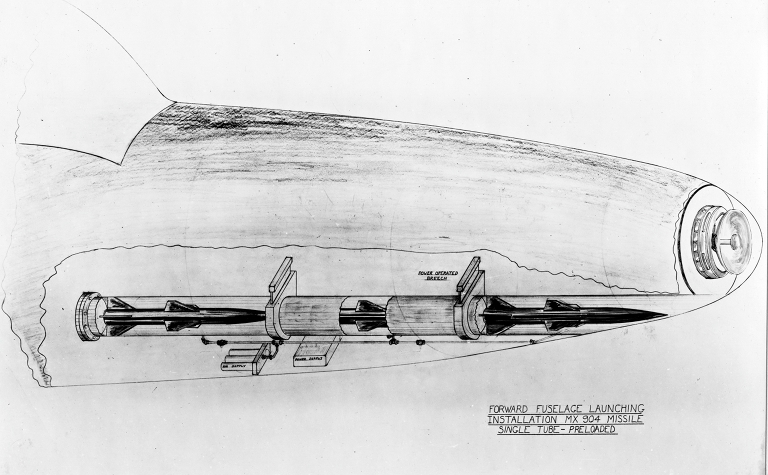 Tube-launched MX-904
concept for the F-89 (National Archives via Dennis R. Jenkins)
The definitive GAR-1 configuration
emerged in early 1951 as a compact weapon designed for internal
carriage on interceptors. The small weapon was 77.8 inches long, had
a diameter of 6.4 inches, and a wingspan of 20 inches. The 134-pound
weight accounted for the SARH guidance and control systems, rocket
motor, and the contact-fused blast warhead. The warhead only
contained 2.7 pounds of explosive and required a direct hit on the
target to detonate due to the use of contact fusing; this did not
necessarily represent a major drawback at the time when engaging
non-maneuverable strategic bombers. The airframe featured delta
wings with rear-mounted control surfaces and fixed canards.In August of 1951, the USAF assigned additional designators to the GAR-1 missile. Despite the deletion of a bomber-specific missile requirement, the USAF still envisioned two weapons at this stage: a missile suitable for subsonic fighters, the XF-98, and a missile suitable for supersonic fighters, the XF-98A. The two-missile concept likely stemmed from the first two projected platforms for the Falcon. While the F-89 Scorpion would emerge as the initial operational carrier of the Falcon, the first carrier selected to employ the GAR-1 in May of 1949 was the forthcoming “1954 interceptor”.
YGAR-1 missile, outwardly similar
to the production GAR-1 (USAF via Robert Sullivan)
Eventually, the USAF dropped the separate XF-98 concept, as the performance envelopes of projected interceptors increased. The early USAF practice of assigning fighter-series designators to AAMs under the consideration that the missiles were unmanned interceptors ended on 15 August 1955. At this point, the Falcon relied solely on the GAR-series designation system. GAR-1 air launches began in May of 1951 with XF-98-type missiles, lacking warheads and guidance systems. By the middle of 1952, test platforms including modified B-25s launched 19 YGAR-1s, employing YF-98A-type missiles featuring guidance systems but still lacking warheads. The first mock intercept with an unarmed YGAR-1 occurred in June when a B-25 successfully engaged a QB-17. The QB-17, a drone conversion of the World War II bomber, served as a suitable target for anti-bomber defensive programs.  The aftermath of a Falcon QB-17 intercept on 21 October 1953 (National Archives via Dennis R. Jenkins) Perhaps echoing the original GAR-1 bomber-launched concept, the B-25 served as a common launch platform for early trials, including ground launched tests directed at stationary targets. On 21 October 1953, a modified F-89D fired an unarmed GAR-1 from a wingtip pod. While the test was a failure as the pod collapsed following missile launch, it signaled the beginning of Falcon missile testing using USAF interceptors as the launch platforms.
Stationary B-25 used for ground-launches of Falcon airframes (National Archives via Dennis R. Jenkins) YGAR-1 firing trials continued through 1954, with Hughes constantly working to update the missile’s configuration and guidance system. By May of 1954, F-89s had fired 10 GAR-1s at targets, scoring seven hits. On 27 January 1955, an F-89D destroyed a QB-17 with a GAR-1 containing a live warhead, marking the missile’s first successful intercept employing a USAF interceptor. In March of 1954, the USAF had ordered 156 F-89H interceptors, to be equipped with six Falcon missiles as part of their armament suite, representing the first Falcon launch platform to reach service. Hughes had delivered the first production-standard missiles to the USAF in 1954, but issues with the F-89H’s wingtip missile pods and other problems prevented IOC from being reached for nearly two years. Finally, however, the GAR-1 reached IOC in March of 1956 with the F-89H as its launch platform. This marked the first operational interceptor/radar-guided AAM combination in the USAF. The successful development of the GAR-1 led to its inclusion in the F-101B’s projected weapon system on 20 June 1955. Crewmembers inspect mock GAR-1 missiles on the F-89H prototype (USAF via Robert Sullivan) XGAR-1BIn November of 1951, Hughes began development of an IR sensor for the Falcon missile. Initial sensor development concluded in 1954. Hughes mated the IR sensor to the GAR-1 airframe and produced the XGAR-1B, intended to complement the SARH-guided GAR-1. In September of 1954, the XGAR-1B scored its first air-to-air hit against a target drone, validating the IR-guided Falcon concept.The appearance of the XGAR-1B affected more than just the USAF’s interceptor fleet. The USAF’s director of requirements, Brigadier General Price, ordered the development of effective countermeasures against attack by IR-guided weapons. Gen. Price’s comments were likely the result of the appearance of the Hughes IR-guided XGAR-1B. EpilogueWith more advanced Falcon variants in development and testing, the GAR-1 did not remain operational with the USAF for an extended period. Furthermore, it does not appear that the original IR-guided Falcon, the XGAR-1B, ever entered operational service. Production of the GAR-1 configuration ended in November of 1956, with the missile withdrawn from use by 1960. |
||||||||||||||||||||||||||||||||||||||||||||||||||||||||||||||||||||||||||||||||||||||||||||||||||||||||||||||||||||||||||||||||||||||||||||||||||||||||||||||||||||||||||||||||||||||||||||||||||||||||||||||||||||||||||||||||||||||||||||||||||||||||||||||||||||||||||||||||||||||||||||||||||||||||||||||||||||||||||||||||||||||||||||||||||||||||||||||||||||||||||||||||||||||||||||||||||||||||||||||||||||||||||||||||||||||||||||||||||||||||||||||||||||||||||||||||||||||||||||||||||||||||||||||||||||||||||||||||||||||||||||||||||||||||||||||||||||||||||||||||||||||||||||||||||||||||||||||||||||||||||||||||||||||||||||||||||||||||||||||||||||||||||||||||||||||||||||||||||||||||||||||||||||||||||||||||||||||||||||||
IV. Improved Falcons |
||||||||||||||||||||||||||||||||||||||||||||||||||||||||||||||||||||||||||||||||||||||||||||||||||||||||||||||||||||||||||||||||||||||||||||||||||||||||||||||||||||||||||||||||||||||||||||||||||||||||||||||||||||||||||||||||||||||||||||||||||||||||||||||||||||||||||||||||||||||||||||||||||||||||||||||||||||||||||||||||||||||||||||||||||||||||||||||||||||||||||||||||||||||||||||||||||||||||||||||||||||||||||||||||||||||||||||||||||||||||||||||||||||||||||||||||||||||||||||||||||||||||||||||||||||||||||||||||||||||||||||||||||||||||||||||||||||||||||||||||||||||||||||||||||||||||||||||||||||||||||||||||||||||||||||||||||||||||||||||||||||||||||||||||||||||||||||||||||||||||||||||||||||||||||||||||||||||||||||||
Improving the FalconIn 1951, Hughes began to develop an improved model of the GAR-1. The goal of this program was to increase the effective performance envelope of the missile, particularly in altitude.Development of the improved Falcon missiles began in 1951 while the GAR-1 was still undergoing testing. Early GAR-1 missiles could intercept a target at an altitude of 50,000 feet. The new Falcons would be capable of intercepting targets up to 60,000 feet, in part thanks to the increasing performance of the interceptors under development. It made sense that if interceptor performances were increasing then a similar increase in bomber performance would occur, necessitating the increase in reach. GAR-1DThe first improved Falcon to emerge was the GAR-1D. The SARH-guided GAR-1D was fractionally larger than earlier Falcons with a length of 78 inches, but the remaining dimensions remained the same as the GAR-1. The primary change to the GAR-1D was in planform. Hughes separated the control surfaces from the delta wings by shifting the wings forward, with the new surfaces manipulated by hinge arms attached to the trailing edges of the wings.  General
arrangement drawings of the GAR-1 and GAR-1D (Sean O’Connor)
The initial platform for the GAR-1D was the F-102. The F-102 was the interim solution fielded under the “1954 Interceptor” concept, the final iteration being the future F-106, now referred to as the “Ultimate Interceptor”. Hughes proposed the F-102, already expected to employ the GAR-1, as a GAR-1D carrier in October of 1953. A study indicated that the F-102 would be capable of intercepting targets at 60,000 feet with the basic GAR-1 thanks to its projected performance envelope, and the USAF eliminated GAR-1D capability from the weapon system’s requirements before returning it in March of the following year. GAR-1D flight trials began in 1955. The weapon entered service in 1956, almost simultaneously with the GAR-1. In December of 1956, three F-102As deployed to Eglin AFB for GAR-1D firing trials. Of 20 GAR-1D missiles launched at targets, only one achieved a hit. This should not have come as a surprise to the USAF; during a conference in late November of 1956, the service criticized the Falcon missile program due to a failure rate in testing of roughly 50%. 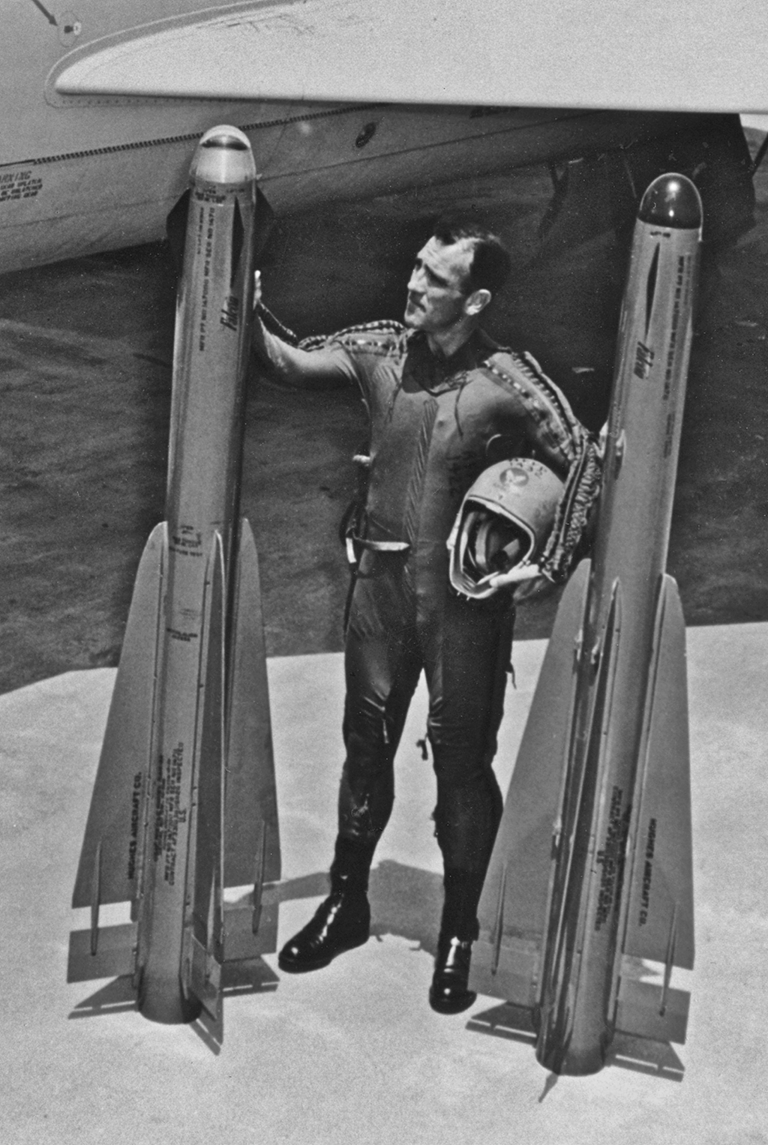 GAR-2 (left) and GAR-1D (right) in front of an F-102 (USAF via Robert Sullivan) The USAF temporarily halted GAR-1D production and removed the missile from service to correct deficiencies in the missile, before resuming testing in February of 1957. This time, the USAF deemed the Falcon’s performance to be satisfactory, allowing production to resume. Because of the GAR-1D’s success, the USAF also added GAR-1D capability into the requirements for the F-101B’s weapon system. In May of 1957, four F-102 squadrons participated in Operation FAST DRAW at Eglin AFB for further evaluation of the interceptor and its MG-10 fire control system. The GAR-1D performance once again rated satisfactory, validating the F-102’s capability for continental air defense. As a result, the GAR-1D re-entered service in mid-1958. Earlier in the year, Hughes added compatibility for the GAR-1D into the MG-13 FCS for the F-101B. GAR-2 and GAR-2ADevelopment of an IR-guided counterpart to the GAR-1D began in July of 1952. This weapon, designated GAR-2, was 1.5 inches longer than the GAR-1D due to the IR seeker. Hughes proposed the GAR-2 for the F-102 at the same time the company proposed the GAR-1D in late 1953. Unlike the GAR-1D, the GAR-2 remained part of the F-102’s armament suite throughout development. Given that both weapons employed the new high-altitude configured airframe, it may indicate that the initial IR weapon under consideration was in fact the earlier XGAR-1B. The GAR-2’s IR seeker encountered problems during testing. In July of 1957, F-102 units conducted Operation FAST DRAW Follow-On at Eglin AFB. While FAST DRAW evaluated the GAR-1D, the follow-on exercise evaluated the GAR-2. Every GAR-2 launched during this exercise failed. During continued testing of the GAR-2, Hughes determined that the IR seeker was very susceptible to external interference from environmental sources such as haze, clouds, and the sun. As the seeker operated in the 2-3 micron range, this was not surprising. Hughes proposed a two-year program to evaluate and solve the issues with the GAR-2. During this period, low-altitude evaluation of the weapon in 1959 illustrated that it was virtually unusable in that environment. The eventual solution was the addition of micron filters to the IR seeker, although this did not completely alleviate the problem.
GAR-2BIn April of 1962, Hughes began work on modifying the GAR-2A with a new IR seeker. The IR seeker, taken from the GAR-4A employed by the F-106, operated in the 3-6 micron range. This made the seeker far less susceptible to external interference. By December of 1962, the GAR-2B achieved its first air-to-air intercept of a target. It entered production as the AIM-4D, following the Department of Defense’s new standardized designation system, in February of 1963, with service entry coming the following July. Apart from new production, Hughes remanufactured surplus GAR-1D and GAR-2A missiles to AIM-4D standard. The AIM-4D was unique among Falcon variants at the time insofar as its intended use was concerned. Hughes designed previous Falcon missiles to intercept enemy bombers. While the AIM-4D would replace earlier GAR-2A missiles on the F-101B and F-102, the USAF also intended to field the AIM-4D on tactical fighters beginning with the F-4 Phantom II, with an aim towards employing the missile in fighter-on-fighter combat. In this role, the AIM-4D would replace the USN’s AIM-9. As a result, the AIM-4D gained not only a new seeker head, but a moisture proof sleeve over the forward fuselage intended to make it suitable for external carriage on tactical aircraft not featuring internal weapon bays. 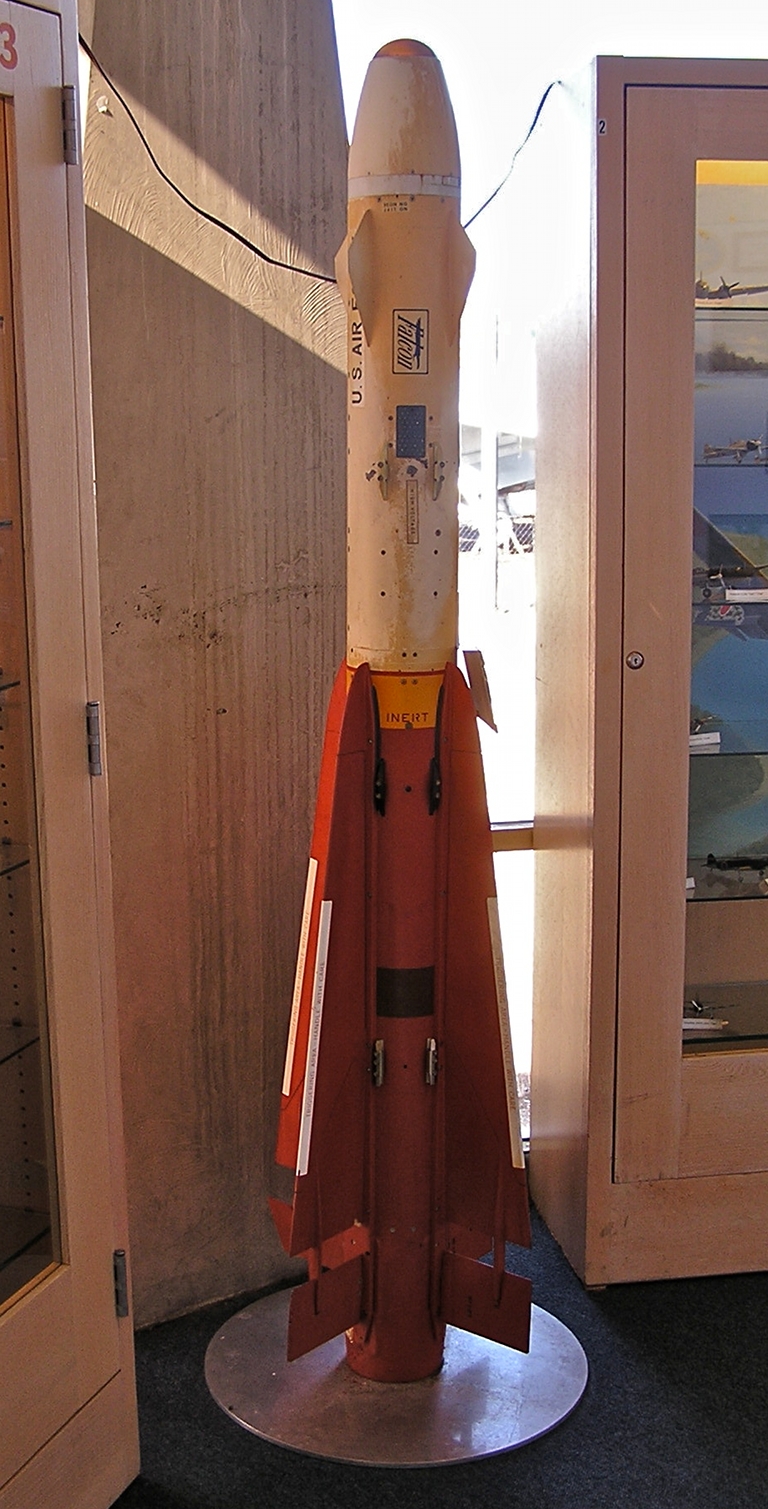 AIM-4D on display at Air Power Park
in Hampton Roads, Virginia (Sean O’Connor)
The USAF issued SOR 200 on 29 August 1962, outlining the desired weapon system for the forthcoming F-4C. On 17 November 1964, the USAF amended SOR 200 to include AIM-4D capability under Project DANCING FALCON. To avoid production delays, however, F-4Cs did not receive the modifications necessary to employ the AIM-4D until the middle of 1968, although the aircraft saw AIM-9 capability return in April of 1969. The F-4D and F-4E featured AIM-4D capability from the outset, with the F-4D gaining AIM-9 capability in June of 1969 and the F-4E featuring it during production. The USAF conducted F-4 trials with the AIM-4D in late 1965, particularly to evaluate the external carriage system. As the AIM-4D represented an addition to the Phantom II’s arsenal, it required a relatively complex method of carriage. The F-4 carried the AIM-4D on LAU-42/A launch rails, mounted on the inner wing pylons. With two rails per pylon, a maximum of four AIM-4Ds was possible. The rails, mounted both below and on the inboard face of each pylon, did not share the same configuration. The larger inner rail featured the nitrogen supply required to cool the seeker head prior to launch, a decision likely made to allow the F-4 to forego the lower rails in order to carry other ordnance on the pylon itself. The trials took place at Eglin AFB. Following its combat employment over Vietnam, the AIM-4D gradually disappeared from use by the F-4 during the 1970s. XAIM-4HThe XAIM-4H appeared as the final iteration of the GAR-1D aerodynamic layout, intended to correct many of the deficiencies of the AIM-4D in the anti-fighter role. The USAF funded development of the XAIM-4H in 1969, once the AIM-4D’s limitations in anti-fighter combat had been highlighted in the skies over Vietnam. The XAIM-4H employed a modified AIM-4D airframe and IR seeker, but added an active optical proximity fuse. This alleviated the traditional Falcon requirement of a direct hit for warhead detonation, potentially making the XAIM-4H more capable against maneuvering targets. The XAIM-4H reportedly introduced a new warhead and enhanced maneuverability as well. Hughes produced 25 XAIM-4H test rounds between 1970 and 1971. At least two intercept tests took place, with XAIM-4H missiles destroying QF-104A target drones on January 26 and July 17 of 1971. Ultimately, this penultimate anti-fighter Falcon found itself as a victim of budgetary constraints in late 1971, with newer variants of the AIM-9 becoming the standard “dogfight” missile for USAF fighters.
EpilogueBeginning with the GAR-1D, Hughes continuously refined the aerodynamics and internal components of the Falcon missiles to meet new objectives and offer new capabilities. When the F-102 finally bowed out from ANG service on 28 January 1977, the remaining GAR-1D and GAR-2A missiles followed, the F-101B relying solely on the GAR-2B for its guided missile armament at this point. |
||||||||||||||||||||||||||||||||||||||||||||||||||||||||||||||||||||||||||||||||||||||||||||||||||||||||||||||||||||||||||||||||||||||||||||||||||||||||||||||||||||||||||||||||||||||||||||||||||||||||||||||||||||||||||||||||||||||||||||||||||||||||||||||||||||||||||||||||||||||||||||||||||||||||||||||||||||||||||||||||||||||||||||||||||||||||||||||||||||||||||||||||||||||||||||||||||||||||||||||||||||||||||||||||||||||||||||||||||||||||||||||||||||||||||||||||||||||||||||||||||||||||||||||||||||||||||||||||||||||||||||||||||||||||||||||||||||||||||||||||||||||||||||||||||||||||||||||||||||||||||||||||||||||||||||||||||||||||||||||||||||||||||||||||||||||||||||||||||||||||||||||||||||||||||||||||||||||||||||||
V. “Super” Falcons |
||||||||||||||||||||||||||||||||||||||||||||||||||||||||||||||||||||||||||||||||||||||||||||||||||||||||||||||||||||||||||||||||||||||||||||||||||||||||||||||||||||||||||||||||||||||||||||||||||||||||||||||||||||||||||||||||||||||||||||||||||||||||||||||||||||||||||||||||||||||||||||||||||||||||||||||||||||||||||||||||||||||||||||||||||||||||||||||||||||||||||||||||||||||||||||||||||||||||||||||||||||||||||||||||||||||||||||||||||||||||||||||||||||||||||||||||||||||||||||||||||||||||||||||||||||||||||||||||||||||||||||||||||||||||||||||||||||||||||||||||||||||||||||||||||||||||||||||||||||||||||||||||||||||||||||||||||||||||||||||||||||||||||||||||||||||||||||||||||||||||||||||||||||||||||||||||||||||||||||||
Delta Dagger to Delta DartThe F-106 represented the USAF’s ideal “1954 Interceptor”, proposed in 1949. Problems with the development of the MX-1179 fire control system led to a 1951 decision regarding the production of two separate interceptors. The F-102A, regarded at this point as an interim solution, would enter service first, while the development of the more advanced F-102B “Ultimate Interceptor” would proceed for service entry later. As it turned out, the F-102 suffered delays of its own, before entering service in 1956. The USAF redesignated the F-102B as the F-106 in June of 1956, and the first examples entered service in 1959, five years after the service’s initial plans. Arming the Ultimate InterceptorBy the end of 1955, the armament suite for the F-106 consisted of a Genie nuclear weapon and 2.75-inch rockets, with 6 Falcon missiles and 40 rockets as an alternate load. The USAF dropped the requirement for rocket armament after a short period, with the primary loadout modified to a single Genie and four Falcon missiles. These Falcons would be the GAR-1A and a weapon described as an advanced GAR-2. As these new weapons offered increased performance and enhanced capabilities, and only armed the F-106, they received the name Super Falcons to differentiate them from their older brethren. 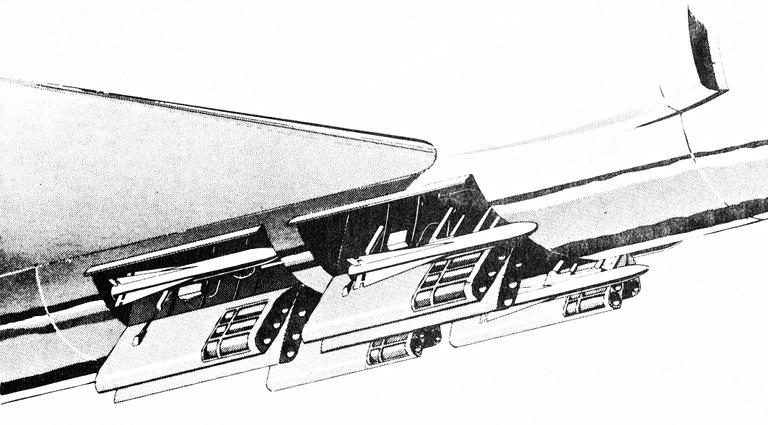 Early F-106 armament concept showing GAR-1A missiles and rocket tubes (USAF via Ryan Crierie) Super Falcon GenesisHughes initiated work on the GAR-1A in January 1952, with work on the GAR-1C following in January of 1954. The GAR-1A and GAR-1C represented SARH and IR-guided weapons sharing a new aerodynamic configuration. This configuration served to increase the compatibility of the weapon with supersonic interceptors. By August of 1953, the GAR-1A employed a modified GAR-1 planform, with extensions added to the wing surfaces in the form of lateral strakes along the forward fuselage. This configuration was revised, likely as a result of GAR-1D development, and by the end of 1954 both the GAR-1A and GAR-1C resembled the GAR-1D save for the lack of canard surfaces and the inclusion of revised nose profiles allowing launch at higher speeds. Further improvements made to the GAR-1A and GAR-1C included a new two-stage rocket motor incorporating boost and sustain capability, and a refined warhead with nearly double the explosive content of the GAR-1 at 5 pounds. By 1956, the GAR-1A and GAR-1C had been redesignated GAR-3 and GAR-4, respectively.  GAR-1A configurations
from August 1953 and November 1954 (Sean O’Connor)
GAR-3Testing of the GAR-3 began in the middle of the 1950s, with the GAR-3 scoring its first air-to-air hit in July of 1955. Full testing of the missile and MX-1179 FCS, now redesignated the MA-1, remained a relatively protracted experience due to delays with both the FCS and the F-106. Two F-106As finally arrived at Holloman AFB to begin weapon system trials over the White Sands Missile Range in August of 1958. F-106 trials with the GAR-3 began in March of 1959 following trials of the Genie rocket. The GAR-3 proved to be problematic, with a June 1959 test resulting in only one of two missiles fired at a QF-80 drone striking the target. As the Super Falcons still relied on a proximity fuse to detonate the warhead, this was not an overly satisfactory result. Initial F-106 weapons trials with the GAR-3 ended on 21 August 1959 when a GAR-3 destroyed a QF-80 drone. Further trials continued in October and November of 1959, with one test seeing an F-106 fire the GAR-3 in automatic mode under the control of the MA-1 FCS. 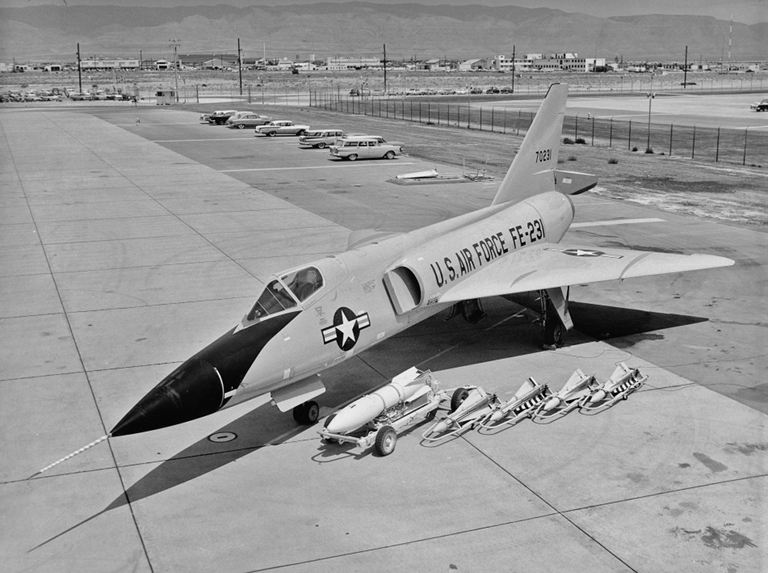 An F-106A displayed
with a Genie rocket and four GAR-3 missiles (USAF via Robert
Sullivan)
Production of the GAR-3 began in 1958, with the weapon intended for use on the F-106. Problems in testing and the development of further improved variants led to a short production run of only 300 missiles, however, and operational units rarely used them. GAR-4The GAR-4 represented an IR-guided counterpart to the GAR-3. The GAR-4 mated the improved airframe of the GAR-3 with an IR seeker similar to that of the GAR-2. Hughes produced the GAR-4 in very small quantities. Although it remained in service as late as 1966, it did not enjoy widespread use in the F-106 community.GAR-3A and GAR-4ADevelopment of the improved GAR-3A and GAR-4A missiles began in 1954. These weapons represented substantial improvements over the GAR-3 and GAR-4 variants. Apart from enhancements to the guidance systems, the GAR-3A and GAR-4A introduced a new Thiokol M46 motor with an increased duration sustainer and featured further changes to the Super Falcon’s aerodynamic planform in the form of wing root extensions reminiscent of those found on the 1953 GAR-1A configuration. These extensions underwent various changes over the course of the test program as Hughes continued to improve the missile’s performance. A weatherproof sleeve also enclosed the forward fuselage of the GAR-3A and GAR-4A, protecting the sensitive avionics components.
GAR-4A nose detail showing wing extensions and weatherproof sleeve (Sean O’Connor) In January of 1959, the USAF decided to replace the GAR-3 with the GAR-3A on the F-106. At this time, F-106 production had already begun, and after discussions with Hughes and Convair it was determined that aircraft produced after November of 1959 would feature GAR-3A capability. Any aircraft produced before that point would have GAR-3A capability added during a scheduled Inspect and Repair as Necessary (IRAN) period in June and July of 1960. While not explicitly stated in available materials, it appears that the GAR-4A replaced the GAR-4 at this time as well, given that all references to the IR missile after this point involve the more advanced GAR-4A. By the end of 1959, F-106 airframes assigned to weapons test duties received the necessary modifications to begin GAR-3A and GAR-4A firing trials. Weapons trials took place during the first half of 1960 at Holloman AFB, with additional GAR-4A trials conducted at Eglin AFB in June and July of 1959. Category III testing took place at Tyndall AFB between February and May of 1960. 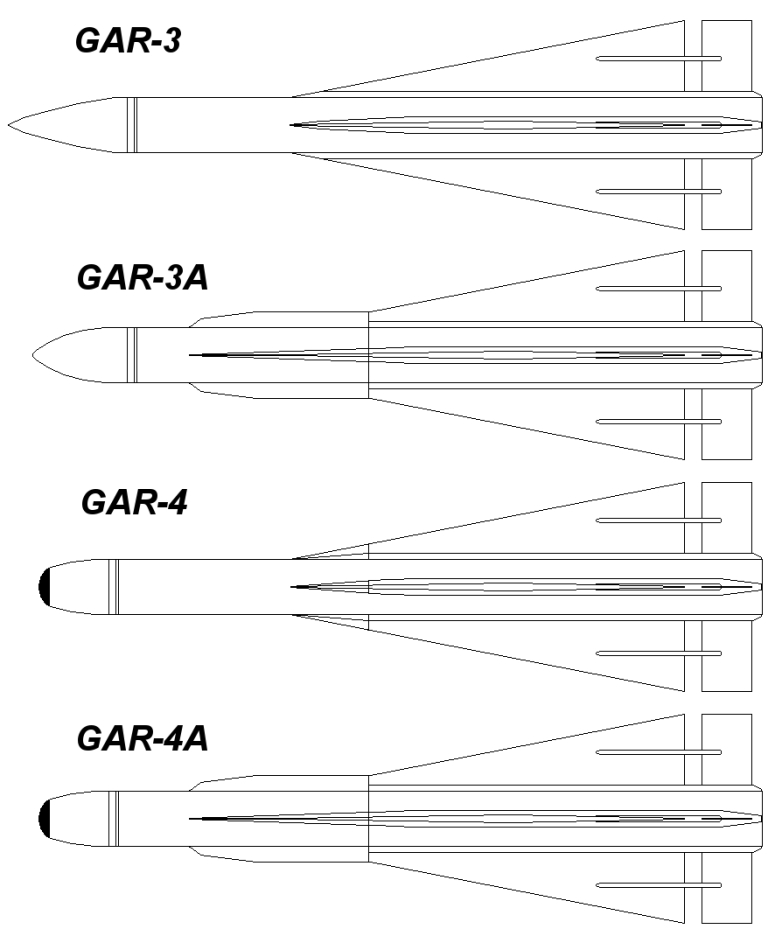 Super Falcon variants
shown to scale (Sean O’Connor)
In 1960, the GAR-3A participated in an unusual and unscheduled test launch. On March 14, an F-106A destroyed a Matador cruise missile. The Matador was performing at the Holloman AFB air show when it became nonresponsive to ground control. Major J.D. Fowler, piloting an F-106A on a test sortie, received orders to intercept and destroy the Matador lest it crash into a populated area. Maj. Fowler’s F-106A carried two GAR-3A rounds, an inert round lacking a warhead and a live weapon not fitted with fusing. After a brief pursuit, Maj. Fowler launched both GAR-3A missiles at the Matador, striking the missile in the engine and causing it to fall to the Earth over an isolated area. A similar incident occurred in March of 1962. A RAM-treated Q-2 drone, under evaluation as a reconnaissance system, launched from a DC-130 over Tyndall AFB. The USAF dispatched five F-106 interceptors to intercept the drone. This time, however, there would be no kill: neither the radar nor the Falcon missiles could acquire the target. This would prove to be one of the few times the USAF interpreted a Falcon missile failure as a successful test, as the drone was demonstrating an early iteration of stealth technology. One issue that appeared during testing concerned the new IR seeker for the GAR-4A. By early 1960, the seeker remained susceptible to external interference, echoing earlier problems with the GAR-2. However, having a solid amount of IR seeker experience under its belt at this time, Hughes quickly solved the problem with the addition of a preamplifier in the guidance system. The production standard GAR-4A emerged as a very capable IR-guided weapon. F-106 pilots claimed that the missile enjoyed a degree of all-aspect capability, able to track Firebee target drones from head-on in certain scenarios. Hughes test pilot James O’Reilly put the potential accuracy of the GAR-4A on display when he launched a single missile at an IR target suspended over White Sands Missile Range. The target was a 36-inch diameter disc heated to simulate jet exhaust, and the unarmed GAR-4A penetrated the disc nearly dead center. EpilogueWith the USAF’s 1959 decision to replace the GAR-3, the GAR-3A and GAR-4A became the primary guided missile armament of the F-106 over the majority of its service career. Hughes began production in 1959, and ended it in December of 1962 after delivery of more than 5,000 Super Falcons. The Super Falcon remained operational with the F-106 until the aircraft’s final retirement from ANG service in 1988. |
||||||||||||||||||||||||||||||||||||||||||||||||||||||||||||||||||||||||||||||||||||||||||||||||||||||||||||||||||||||||||||||||||||||||||||||||||||||||||||||||||||||||||||||||||||||||||||||||||||||||||||||||||||||||||||||||||||||||||||||||||||||||||||||||||||||||||||||||||||||||||||||||||||||||||||||||||||||||||||||||||||||||||||||||||||||||||||||||||||||||||||||||||||||||||||||||||||||||||||||||||||||||||||||||||||||||||||||||||||||||||||||||||||||||||||||||||||||||||||||||||||||||||||||||||||||||||||||||||||||||||||||||||||||||||||||||||||||||||||||||||||||||||||||||||||||||||||||||||||||||||||||||||||||||||||||||||||||||||||||||||||||||||||||||||||||||||||||||||||||||||||||||||||||||||||||||||||||||||||||
VI. Nuclear Falcons |
||||||||||||||||||||||||||||||||||||||||||||||||||||||||||||||||||||||||||||||||||||||||||||||||||||||||||||||||||||||||||||||||||||||||||||||||||||||||||||||||||||||||||||||||||||||||||||||||||||||||||||||||||||||||||||||||||||||||||||||||||||||||||||||||||||||||||||||||||||||||||||||||||||||||||||||||||||||||||||||||||||||||||||||||||||||||||||||||||||||||||||||||||||||||||||||||||||||||||||||||||||||||||||||||||||||||||||||||||||||||||||||||||||||||||||||||||||||||||||||||||||||||||||||||||||||||||||||||||||||||||||||||||||||||||||||||||||||||||||||||||||||||||||||||||||||||||||||||||||||||||||||||||||||||||||||||||||||||||||||||||||||||||||||||||||||||||||||||||||||||||||||||||||||||||||||||||||||||||||||
Early Nuclear EffortsDevelopment of nuclear-armed Falcon missiles began in 1956. Hughes initially sought to develop two nuclear-armed Falcon missile variants, referred to as the XGAR-5 and XGAR-6. The XGAR-5 and XGAR-6 represented significantly larger weapons than the basic Falcons, with their dimensions increased to a length of 140 inches, a diameter of 12 inches, and a wingspan of 40 inches. The XGAR-5 featured SARH guidance, with the XGAR-6 featuring IR guidance. While neither of these projects ever reached the hardware stage, the concept of a nuclear-armed Falcon missile did not stay abandoned for long. The GAR-11Hughes returned to the concept of a nuclear-armed Falcon derivative in 1959. The USAF desired to obtain the capability to intercept Soviet bombers in head-on engagements. Hughes responded with a weapon featuring SARH guidance. Hughes included SARH guidance out of necessity, as the IR guidance systems of the time were incapable of functioning consistently in a head-on engagement. To compensate for the inaccuracy of the era’s SARH guidance systems in a head-on engagement, the weapon employed a nuclear warhead to achieve the desired single-shot kill probability.The weapon that emerged in 1960 was the XGAR-11, a new addition to the Falcon missile family. The XGAR-11 retained the standard Falcon missile aerodynamic layout, with separate delta wings and tail control surfaces, but did away with the canards found on the early weapons. The fuselage featured increased diameter to account for both the nuclear warhead and a new Thiokol M60 motor. Production began that same year following a brief trials program, and the weapon entered service in 1961 as the GAR-11. The nuclear warhead selected for the GAR-11 was the W-54, with a 1.5-kiloton yield. The carrier for the Nuclear Falcon was the F-102. The USAF valued the concept of nuclear-armed air-to-air munitions, having previously developed the AIR-2 Genie. Nuclear weapons could potentially damage or destroy multiple enemy aircraft flying in close formation. As such, they represented potential force multipliers when employed by the interceptor fleet. The USAF initially evaluated the AIR-2 on the F-102 in 1956, but abandoned the project in 1957 to avoid production delays associated with adapting the F-102 to carry and employ the weapon operationally. 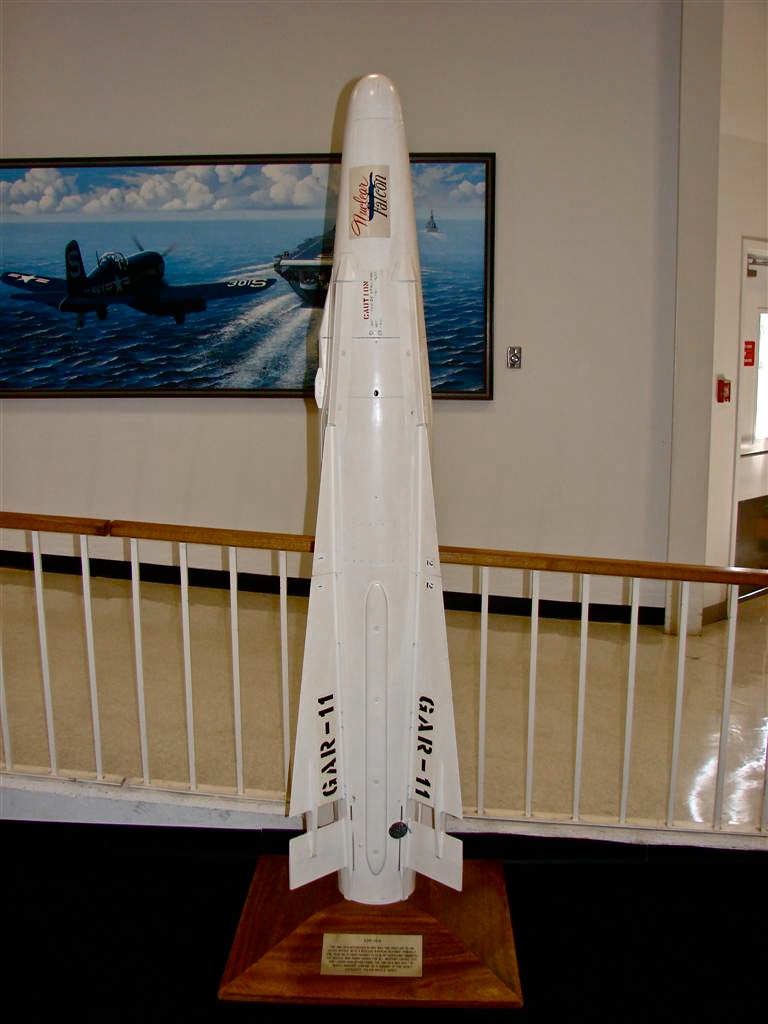 GAR-11 displayed at the National
Museum of Naval Aviation (Wikimedia)
Beginning in 1961, F-102s underwent modification to accept the GAR-11, which was dimensionally larger than the other Falcon variants employed. As a result, F-102s only gained the ability to carry the GAR-11 in the center weapons bay, giving a maximum load of two weapons. Modification of the F-102 to permit the carriage of the GAR-11 necessitated the removal of the FFAR tubes from the inner bay doors to accommodate the increased wingspan of the missile. The GAR-11, redesignated AIM-26A in 1963, enjoyed numerous features setting it apart from its Falcon brethren. The combination of SARH guidance and the W-54 warhead provided the GAR-11 with an all-aspect, all-weather engagement capability. Previous Falcon variants often suffered from guidance system issues requiring lengthy test programs to rectify, or did not possess the ability to perform head-on engagements. The addition of a proximity fuse also negated the typical Falcon requirement of a direct hit on the target to detonate the warhead. Development of the conventional GAR-11A took place alongside the nuclear-armed GAR-11. F-102s received modifications to use the conventional weapon beginning in February of 1962. Hughes produced the GAR-11A between August of 1962 and December of 1963. As the weapon was merely a modification of an existing AAM, it entered service with the F-102 one month prior to the first air launch from the aircraft in October of 1962. Initial testing occurred in May of 1962, with the weapon scoring hits in all eight of the test launches. While only six F-102 squadrons received modifications to employ the nuclear GAR-11, it appears that the majority of USAF and ANG squadrons received the capability to employ the conventional GAR-11A. EpilogueThe nuclear-armed GAR-11 left active service by April of 1972, with the withdrawal of the W-54 warhead. With the retirement of the F-102 in 1976, the GAR-11A left the active inventory. Thus ended the operational careers of the most powerful and sophisticated Falcons deployed in the United States. |
||||||||||||||||||||||||||||||||||||||||||||||||||||||||||||||||||||||||||||||||||||||||||||||||||||||||||||||||||||||||||||||||||||||||||||||||||||||||||||||||||||||||||||||||||||||||||||||||||||||||||||||||||||||||||||||||||||||||||||||||||||||||||||||||||||||||||||||||||||||||||||||||||||||||||||||||||||||||||||||||||||||||||||||||||||||||||||||||||||||||||||||||||||||||||||||||||||||||||||||||||||||||||||||||||||||||||||||||||||||||||||||||||||||||||||||||||||||||||||||||||||||||||||||||||||||||||||||||||||||||||||||||||||||||||||||||||||||||||||||||||||||||||||||||||||||||||||||||||||||||||||||||||||||||||||||||||||||||||||||||||||||||||||||||||||||||||||||||||||||||||||||||||||||||||||||||||||||||||||||
VII. Export Falcons |
||||||||||||||||||||||||||||||||||||||||||||||||||||||||||||||||||||||||||||||||||||||||||||||||||||||||||||||||||||||||||||||||||||||||||||||||||||||||||||||||||||||||||||||||||||||||||||||||||||||||||||||||||||||||||||||||||||||||||||||||||||||||||||||||||||||||||||||||||||||||||||||||||||||||||||||||||||||||||||||||||||||||||||||||||||||||||||||||||||||||||||||||||||||||||||||||||||||||||||||||||||||||||||||||||||||||||||||||||||||||||||||||||||||||||||||||||||||||||||||||||||||||||||||||||||||||||||||||||||||||||||||||||||||||||||||||||||||||||||||||||||||||||||||||||||||||||||||||||||||||||||||||||||||||||||||||||||||||||||||||||||||||||||||||||||||||||||||||||||||||||||||||||||||||||||||||||||||||||||||
HM-55 and HM-58During the 1950-1960 timeframe, AAMs became the armament of choice for fighters and interceptors. Advances in missile technology seemed to make the cannon an afterthought, with many USAF interceptors such as the F-89J featuring all-missile armament.The GAR-11A’s capabilities and performance translated well to the world’s AAM market at the time. Furthermore, the proximity-fused warhead enabled the weapon to be potentially effective against more agile targets than previous Falcon variants. Hughes exported the GAR-11A under the designation HM-55. Likewise, Hughes exported the IR-guided GAR-2A as the HM-58. Hughes often mated these weapons with compatible fire control systems. SwitzerlandSwitzerland procured the HM-55 in 1961 to arm its planned fleet of Dassault Mirage IIIS fighters. The Mirage IIIS featured a Hughes TARAN-18 fire control system, permitting employment of the HM-55. Switzerland ordered 225 HM-55s, with Hughes delivering the weapons between 1965 and 1968. Between 1966 and 1969, 36 Mirage IIIS fighters entered service with the Swiss Air Force, with the majority assembled under license.The first Swiss Mirage to trial the HM-55 was not a Mirage IIIS, but rather a Mirage IIIC purchased in 1962. This aircraft, serial J-2201, validated the weapon separation characteristics of the HM-55 from the Mirage airframe while flying over Cazaux, France in 1964. 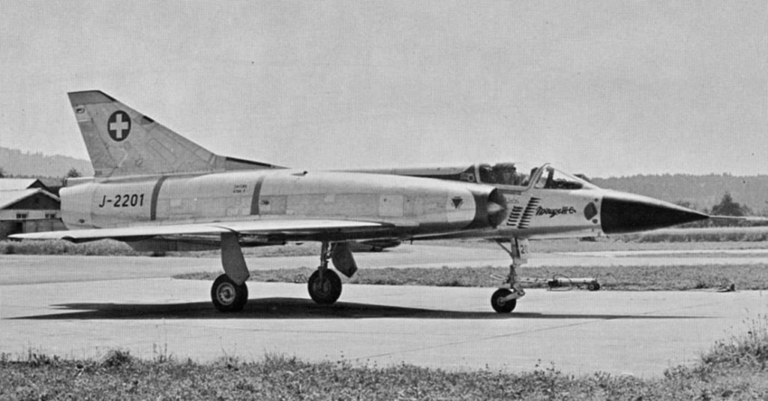 Mirage IIIC J-2201,
used in HM-55 separation trials (Swiss Air Force)
Hughes was not idle regarding weapons trials. The HM-55/TARAN-18 combination underwent trials at White Sands Missile Range beginning in 1965. The first HM-55 launch under the Swiss trials program took place in April of 1965, followed by a second launch in October. Between February and July of 1966, a further 40 launches took place. The HM-55 remained part of the armament of the Mirage IIIS into the early 1990s. Until the arrival of the Mirage’s replacement in the form of the AMRAAM-equipped F/A-18C Hornet, it remained the only radar-guided AAM in Swiss service.  The first J-35F, armed with Saab
Rb.27 (underfuselage) and Rb.28 (underwing) Falcon AAMs (SAAB).
SwedenSweden began its relationship with the Falcon missile in 1959. The Swedish Air Force sought a new missile to arm later variants of the J-35 Draken family, desiring an AAM capable of engaging targets at altitudes up to 15,000 meters. This requirement stemmed from the fact that evolving variants of the Draken, particularly the J-35D, enjoyed increased performance envelopes.Sweden initially ordered the HM-58 in 1959, placing a separate order for the HM-55 in 1961. Saab-Bofors assembled Swedish Falcons under a license-production agreement with Hughes. As a result, the HM-55 and HM-58 received the designations Rb.27 and Rb.28. Saab-Bofors produced 400 Rb.27 and 3,000 Rb.28 rounds. Initially, the HM-58 represented an export variation of the USAF’s GAR-2A. However, during the 1960’s Saab-Bofors began to modernize the Rb.28 to improve its effectiveness. The resultant was a de-facto GAR-2B, with Saab-Bofors undertaking the conversion work necessary to incorporate the IR seeker head from the GAR-4A. Swedish sources suggest that because of other undisclosed modifications to the Rb.28, the resultant weapon represented the most effective IR-guided Falcon variant ever fielded, even enjoying superior performance when compared to the USAF’s experimental AIM-4H. The J-35F became the first Draken variant to employ Swedish-built Falcons. The Ericsson PS-01/A radar provided signals for the Rb.27’s SARH guidance. Modifications to the radar system to accept inputs from an IRST unit occurred in 1967, the radar being redesignated PS-11/A. The J-35F demonstrator first flew in 1961, with the test fleet expending approximately 80 Falcon missiles during system trials ending in 1966. 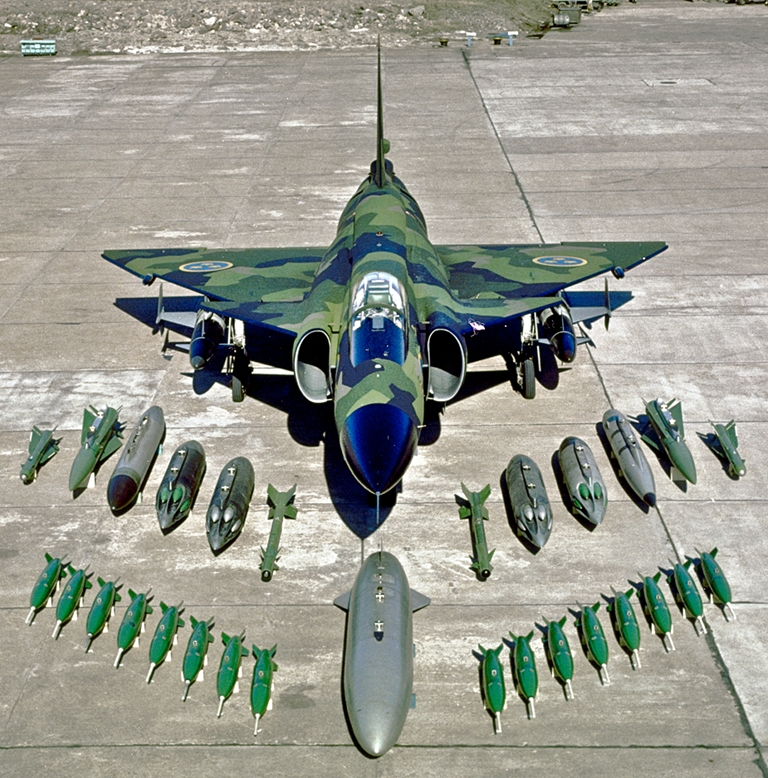 AJ-37 displayed with weapons
options, including the Rb.28 (Saab AB)
Rb.27 and Rb.28 missiles also comprised the primary armament of the final Draken variant, the J-35J, which first appeared in 1987. The J-35J represented a modification of 67 J-35F airframes rather than a new production variant. The J-35J served until Sweden retired the Draken in 1999. While the Rb.27 remained unique to the Draken in Swedish service, the Rb.28 was included in the initial armament package for derivatives of the more advanced J-37 Viggen. However, usage of the Rb.28 on the Viggen apparently ended following the discovery of handling issues pertaining to carrying AAMs on the outer wing pylons, those wired for Rb.28 carriage. Swedish Drakens and their license-built Falcons found their way to Finland beginning in 1974. Finland contracted with Saab to license-build 12 J-35F Drakens as the Saab 35S in 1970, the aircraft being constructed between 1974 and 1975. In 1976, a further six ex-Swedish J-35Fs were procured, followed by 18 further examples in 1984. These aircraft received the designation 35FS. Finnish 35S and 35FS Drakens employed both the Rb.27 and Rb.28, serviced in country by Finnish technicians at Valmet. Like the Swiss Mirage IIIS, Finnish Falcon carriers found themselves replaced by the F/A-18C. Finland retired the 35S and 35FS in 2000. Beginning in the 1990s, Sweden and Finland users apparently began a gradual phase-out of the weapon, retaining the SARH Rb.27. The apparent replacement for the Rb.28 Falcon would once again be a member of the AIM-9 family, commonly carried by Swedish Drakens in mixed loads with the Rb.27. AIM-4D ExportsApart from the HM-55 and HM-58, Hughes exported the AIM-4D to various clients employing suitable launch platforms for the weapon. The initial users were Canada, Greece, and Turkey, all of whom employed interceptors that relied on the Falcon missile as their primary or secondary armament. AIM-4D integration with the F-4 saw the missile exported to Iran and Japan to arm F-4D and F-4EJ fighters serving with those nations. The AIM-4D was the final Falcon variant directly exported by the United States, with later users relying on Saab’s license-built missiles.EpilogueFollowing in the footsteps of the delta-wing interceptors of the USAF, Falcon missiles armed European deltas for nearly four decades. While the Rb.28 gradually faded from view over time, the HM-55 and Rb.27 provided Sweden, Finland, and Switzerland with an effective missile with which to defend their airspace. |
||||||||||||||||||||||||||||||||||||||||||||||||||||||||||||||||||||||||||||||||||||||||||||||||||||||||||||||||||||||||||||||||||||||||||||||||||||||||||||||||||||||||||||||||||||||||||||||||||||||||||||||||||||||||||||||||||||||||||||||||||||||||||||||||||||||||||||||||||||||||||||||||||||||||||||||||||||||||||||||||||||||||||||||||||||||||||||||||||||||||||||||||||||||||||||||||||||||||||||||||||||||||||||||||||||||||||||||||||||||||||||||||||||||||||||||||||||||||||||||||||||||||||||||||||||||||||||||||||||||||||||||||||||||||||||||||||||||||||||||||||||||||||||||||||||||||||||||||||||||||||||||||||||||||||||||||||||||||||||||||||||||||||||||||||||||||||||||||||||||||||||||||||||||||||||||||||||||||||||||
VIII. The Ultimate Falcon |
||||||||||||||||||||||||||||||||||||||||||||||||||||||||||||||||||||||||||||||||||||||||||||||||||||||||||||||||||||||||||||||||||||||||||||||||||||||||||||||||||||||||||||||||||||||||||||||||||||||||||||||||||||||||||||||||||||||||||||||||||||||||||||||||||||||||||||||||||||||||||||||||||||||||||||||||||||||||||||||||||||||||||||||||||||||||||||||||||||||||||||||||||||||||||||||||||||||||||||||||||||||||||||||||||||||||||||||||||||||||||||||||||||||||||||||||||||||||||||||||||||||||||||||||||||||||||||||||||||||||||||||||||||||||||||||||||||||||||||||||||||||||||||||||||||||||||||||||||||||||||||||||||||||||||||||||||||||||||||||||||||||||||||||||||||||||||||||||||||||||||||||||||||||||||||||||||||||||||||||
The Long Range InterceptorBy 1953, the USAF was beginning to study a new interceptor to counter the threat of Soviet bombers. The USAF referred to its desired aircraft as the Long Range Interceptor, or LRI, a moniker applied to reference the desired 1,000-mile combat radius. The USAF studied various configurations, including a Northrop proposal referred to as the “Delta Scorpion.”From the outset, the LRI was a Falcon missile carrier, initially employing the GAR-1 before revised requirements dated April of 1954 included the GAR-1A. Project specifications in October of 1953 called for carriage of eighteen GAR-1 missiles as part of an armament package also incorporating unguided nuclear missiles and air-to-air rockets. By April of 1954, the Falcon component decreased to eight improved GAR-1A missiles. The initial LRI program would not result in any hardware. The F-101B was eventually approved for production as a complement to the F-102A The F-101B offered greater range than the F-102A, partially satisfying the goal of the LRI program to intercept Soviet bombers before they came within weapons-release range of American or Canadian targets. In spite of these setbacks, the USAF began reinvestigating the LRI concept in February of 1957. The modified requirements included new weapons and Mach 3 performance. The requirements also retained the 1,000-mile combat radius of the original LRI project, as the ability to engage Soviet bombers as far afield as possible still had priority. This new LRI would be designated F-108, and the eventual winner of the design competition was North American Aviation. GAR-XTo meet the USAF’s requirements, the F-108 required a new missile, referred to as the GAR-X. Conceived towards the end of the initial LRI program, the first projected characteristics for the GAR-X first appeared in May of 1956. These characteristics called for a range of between 15 and 25 nautical miles with a nuclear or high explosive warhead. The initial GAR-X design also featured an altitude capability of 75,000 feet, and employed both passive radar and IR homing. GAR-X was a large weapon, with a length of 134.5 inches and a wingspan of 41 inches. Although work on this design stopped in August of 1956, the nuclear warhead capability and similar dimensions to the earlier XGAR-5 and XGAR-6 concepts may indicate that the airframe for the earlier weapons survived as the GAR-X.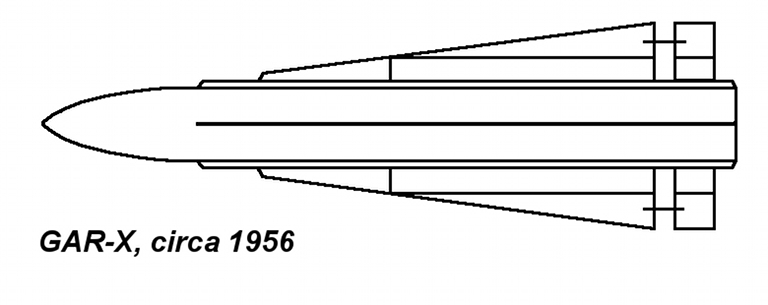 Provisional drawing of
the initial Hughes GAR-X design; note the apparent folding wings
(Sean O’Connor)
References to a new longer-range
missile than the currently available Falcons appeared as far back as
December of 1953, when USAF headquarters envisioned the LRI armed
with a missile with a nuclear or high explosive warhead, with long
range enabling launch outside the range of any defensive systems the
target may be employing. These requirements likely led to the formal
GAR-X. Between February of 1957 and November of 1958, the GAR-X concept underwent various changes. In February of 1957 the F-108’s projected armament suite included Falcon missiles and at least two GAR-X missiles with a 2-kiloton nuclear warhead. By April of 1957, the GAR-X concept had been revised to include SARH guidance, secondary passive guidance (likely IR), and the ability to hit targets within an altitude difference of 40,000 feet of the launching aircraft. Studies in April of 1958 demonstrated that the F-108 would be able to avoid the nuclear warhead’s radius provided launch of the GAR-X took place at a range of no less than 20 nautical miles. May 1958 saw a revision to the F-108’s armament package, which would thereafter include only three GAR-X missiles, with a projected stock of 420 missiles available for each operational wing of F-108s. Alteration to the requirements for the GAR-X took place in November of 1958, to incorporate a desired altitude reach of up to 100,000 feet. GAR-9The GAR-X was officially designated GAR-9 in early 1958, having been assigned to Hughes for development in mid-1957. Like many Hughes AAMs before it, the GAR-9 would also bear the name of Falcon, even though it represented a significantly more capable weapon utilizing a new, considerably larger airframe. In April of 1958 Hughes demonstrated its work on the GAR-9 and associated AN/ASG-18 fire control system (then referred to as XY-1) to the USAF at its Culver City, California plant. The USAF was reportedly pleased with the contractor’s efforts to this point.As it took shape, the GAR-9 of 1958 was turning out to be a large weapon, easily the largest AAM in the world at the time. The projected performance was a speed of Mach 6 and a range of 100 nautical miles. A pre-programmed autopilot controlled the missile for a distance of 62 nautical miles, at which point the SARH seeker would acquire the target and home in for the remaining 38 nautical miles. Initial specifications for the missile seeker called for the ability to acquire a 343 square foot target at 38 nautical miles, but this improved to a 100 square foot target at 63 nautical miles by the end of 1958. The intended powerplant for the large, 818-pound missile was an Aerojet-General XM59 solid rocket motor. Work also began in 1958 on the proposed W-42 0.25-kiloton nuclear warhead for the weapon. However, this work did not progress for very long, the nuclear option eliminated in favor of a 100-pound high explosive warhead triggered by a proximity fuse. Official cancellation of the W-42 came in June of 1961.  GAR-9 mockup displayed in January of 1959 (National Archives via Dennis R. Jenkins) 1959 saw various changes to the GAR-9. Problems with the XM59 led to a brief flirtation with a Lockheed storable liquid fuel motor before Hughes settled on the Lockheed XSR13-LP-1 solid rocket motor. While this did not appear to have had any effect on the GAR-9’s range based on published performance estimates, it did decrease the weapon’s speed to Mach 4. During this period, the USAF also directed Hughes to study a GAR-9 variant incorporating both SARH and IR guidance. The idea, borne out of concerns the USAF had with the GAR-9’s SARH seeker, was to give the missile the ability to remain functional in an ECM-heavy environment. The dual-mode GAR-9 would employ SARH guidance during midcourse flight, with IR terminal homing. Although not specified, it was potentially capable of launch using IR guidance alone. The USAF also directed Hughes to study a version solely employing IR guidance at this time, likely as a backstop against a more serious problem with the SARH guidance system. Hughes eventually reported that the proposed dual-mode weapon would see a 2-inch increase in diameter from 13.5 to 15.5 inches and an increase in weight to 998 pounds. These changes would have necessitated a redesign of the F-108’s weapon bays to accommodate the larger weapon and impose a range penalty due to the increased weight. As this implied a delay in the F-108 program, the USAF eventually dropped the dual-mode weapon, a decision that proved correct in hindsight given that Hughes solved the GAR-9’s SARH seeker issues. 1959 also saw the GAR-9 considered for use from the B-70. Designers considered various defensive systems for the new bomber. One such option was the GAR-9. This concept would not bear any fruit; in the mind of the USAF, the range penalty for adding such a system did not override any added mission effectiveness garnered by the presence of a weapon system such as the GAR-9. On September 23, 1959, the USAF cancelled the F-108 program. Interestingly, the USAF chose to proceed with the development of the Hughes radar and missile system, initially extending the manufacturer’s contract through June of 1960. It appeared that the USAF was developing a weapon without a platform, but the requirement for a long-range, Mach 3 interceptor remained. Arming the AF-12In March of 1960, Kelly Johnson travelled to the Pentagon to brief the USAF on his proposed AF-12, a Mach 3 interceptor version of the CIA’s A-12 reconnaissance aircraft under development at the time. Johnson convinced the USAF of the merits of his proposal, and formal development of the aircraft began in October of 1960 under the codename KEDLOCK. Lockheed produced three prototypes of the new Improved Manned Interceptor by modifying CIA A-12 airframes already in production to accept the AN/ASG-18 and GAR-9, and incorporating a second crew position for a Fire Control Officer responsible for managing the weapon system. When built, these prototypes were designated YF-12As.As produced for the B-58 and AF-12, the GAR-9 primarily consisted of magnesium and plastic. The fuselage and wings were plastic, with the wings bonded to the fuselage. Magnesium structures reinforced the fuselage and mounted the rear control surfaces. The control surfaces were stainless steel honeycomb assemblies. Power for the control surfaces came from pressurized hydraulic fluid routed through the wing root assemblies. A specially modified B-58 undertook the first air launches of the GAR-9. The F-108 program had sought the use of B-58 airframes for weapon system development, and Hughes eventually employed one modified example to continue GAR-9 development following the F-108’s cancellation. The modified B-58, serial 55-665, fielded the AN/ASG-18 radar in a new enlarged nose and a weapons pod capable of carrying and launching a single GAR-9. Convair received a contract to modify 55-665 in October of 1958, with the aircraft delivered to Hughes for radar installation in August of 1959. Following various component test programs, including dropping the weapon into a foam-lined pit to gauge separation characteristics from the B-58’s weapons pod, the GAR-9 began firing trials in 1961. The first ground launch occurred in May of 1961 at the White Sands Missile Range in New Mexico. By the end of the year, eight missiles had been test fired. These initial test launches were of unguided missiles, permitting evaluation of the rocket motor and the aerodynamic configuration. The ground test program continued in 1962, with the first guided ground launch taking place on January 15. The first air launch of a GAR-9 occurred on May 25, 1962. Flying at 35,000 feet, 55-665 launched an unarmed GAR-9 at a QF-80 target approximately 15 miles downrange. The missile performed as advertised, passing within six feet of the target drone. The second launch from 55-665 on August 17 of the same year resulted in the unarmed GAR-9 actually striking the QF-80 target, demonstrating the accuracy of the missile seeker. Perhaps the GAR-9 sensed its Falcon heritage! Air launches of the GAR-9 came to a halt in 1963 due to a test failure. On February 21, a GAR-9 was fired at a Regulus-II target drone from 55-665. The GAR-9 disintegrated in flight, resulting in the suspension of the trials program while Hughes modified the design of the weapon to rectify the problem. Trials resumed with another firing in July of 1963, validating Hughes’s modifications. While details of the exact modifications remain undisclosed, they likely addressed the missile’s control surfaces, as an early GAR-9 depicted with the B-58 testbed possessed different wing designs than those on developed rounds seen later. AIM-47AIn 1963, the Department of Defense’s new standardized designation system resulted in the GAR-9 being redesignated AIM-47A. The B-58/GAR-9 trials program was nearing an end by this point, as the YF-12A prototypes would begin weapons trials in the near future. The last AIM-47A launch from 55-665 took place in February of 1964.AIM-47A trials with the YF-12A began in 1964. On April 16, the first AIM-47A ejection test from a Blackbird took place. This was a trial involving an unarmed, ballasted weapon intended to monitor the missile’s separation from the YF-12A. Fortunately, it was only a test. The AIM-47A exited the YF-12A’s weapons bay with a nose-up attitude; if the weapon was powered, it would have struck the forward fuselage below the cockpits. Lockheed redesigned the ejector system used by the YF-12A, and no further issues arose. Between 1965 and 1966, YF-12A prototypes fired thirteen AIM-47A missiles at various targets. Lockheed flight crews conducted seven launches, with the other six conducted by USAF flight crews. These test launches were unarmed but fully guided, with the missiles homing in on various target drones. The AIM-47A proved capable of hitting targets as low as 500 feet when fired from 75,000 feet and Mach 3.2. Twelve of the thirteen missiles either hit or passed within the high explosive warhead’s lethal radius, the single failure attributed to an internal power failure in a guidance component. By all accounts, the AIM-47A was a formidable weapon, far outstripping the performance and operating envelope of any other contemporary AAM. 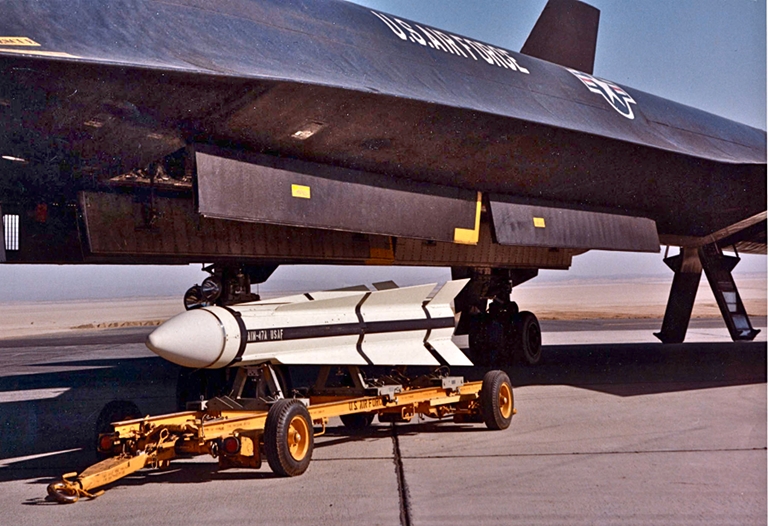
An AIM-47A test round underneath one of the YF-12A prototypes (USAF Museum) AIM-47BIn May of 1965, Lockheed received an engineering contract to begin work on the proposed production F-12B. This would have been a refined version of the YF-12A, and would have used a modified AIM-47B missile. The primary modification to the AIM-47B was the addition of folding fins to allow stowage in a more compact weapons bay. This feature was present on the initial GAR-X design but disappeared shortly thereafter. The AIM-47B retained the same dimensions as the AIM-47A, but was slightly lighter at 800 pounds. The production F-12B would have employed three AIM-47Bs.Ultimately, despite finally resulting in prototypes, the USAF’s quest for a Mach 3 interceptor ended on the first day of February 1968 with the formal cancellation of the F-12B program. With the cancellation, development of the AIM-47 also ceased; there would be no reprieve for the guidance system or the powerful missile this time.  General arrangement
drawings of the AIM-47A and proposed folding-wing AIM-47B (Sean
O’Connor)
Surface Attack DerivativesIn 1966, Hughes proposed a modified AIM-47A for the anti-radar role. The weapon, designated AGM-76A, replaced the AIM-47A’s guidance system and warhead with the passive radar seeker employed by the AGM-45 and the Mk.81 bomb’s 300-pound high explosive warhead. Weight increased to 951 pounds because of the changes, and the weapon was slightly longer than the AIM-47A at 160 inches due to a revised nosecone accommodating the new seeker. The AGM-76A program ended by 1968, as the USAF and USN had accepted a modified, air-launched RIM-66 for the role as the AGM-78.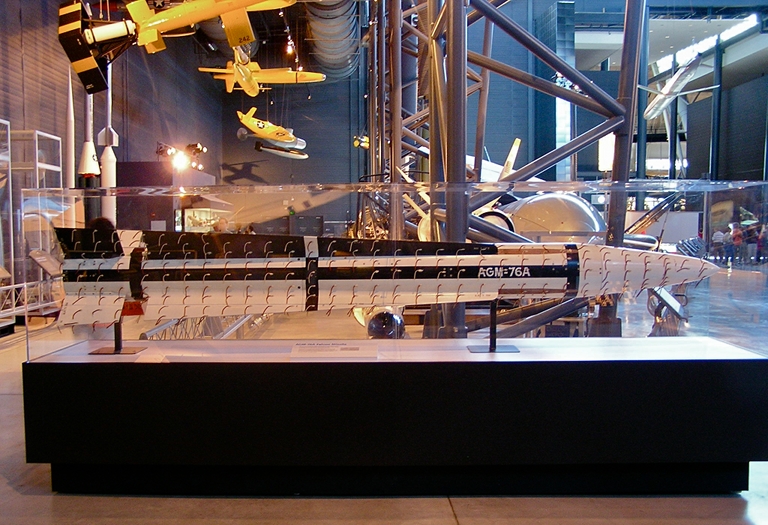 Above: AGM-76A test round on display at the NASM Udvar-Hazy annex; Below: Stenciling detail on the museum’s AGM-76A test article (Sean O’Connor) 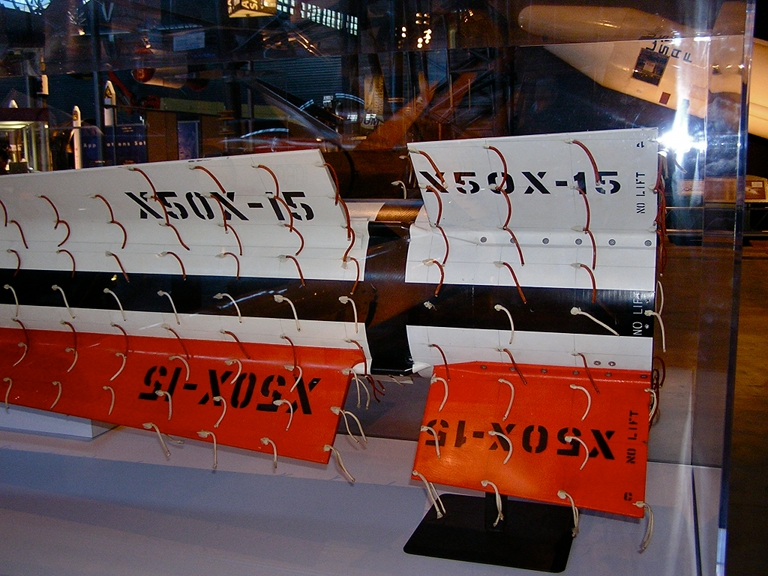 Interestingly, one amusing story regarding the AGM-76A briefly circulated before falling victim to factual evidence. A researcher attempted to pass off the AGM-76A as a CIA-directed program, codenamed GX-15, to arm the production F-12B with a nuclear-armed air-to-ground weapon. A 250-kiloton warhead was reported, allegedly the same warhead planned for the AIM-47A. The story falls apart on multiple grounds without even questioning why the CIA would be controlling a nuclear weapons program for the USAF: the AIM-47A never employed a nuclear warhead (nor was a 250-kiloton warhead even considered), and “GX-15” was likely derived from the serial code X50X-15 stenciled on an AGM-76A test airframe currently on display at the Smithsonian. Regardless, official USAF documentation confirms the projected role of the AGM-76A, as well as details regarding the warhead and guidance system. While the AGM-76A did not feature a nuclear warhead, the USAF considered a nuclear-armed GAR-9 derivative at one point for the surface attack role. Lockheed proposed the RS-12 to the USAF in 1961 as a multi-mission reconnaissance and strike platform capable of performing post-strike reconnaissance and eliminating remaining targets. A two-seat aircraft derived from the CIA’s A-12, the RS-12 was proposed concurrently with the similar R-12, an unarmed variant that later evolved into the SR-71A. The RS-12 proposal’s initial armament consisted of four GAR-9 derivatives modified for a nuclear surface attack role. Each modified GAR-9 employed either a W-47 or W-58 warhead from the US Navy’s Polaris SLBM series. The proposed GAR-9 derivative featured a nominal launch range of 50 miles, and used either radar or optical area correlation guidance for terminal homing. The theorized CEPs of the guidance modes were between 6 (optical) and 15 (radar) meters. EpilogueWhile the AIM-47A did not enter service with any of the USAF’s long-range interceptor designs, the test program proved that it was a viable weapon system. The AIM-47A would ultimately provide Hughes with the baseline for the AIM-54 Phoenix AAM employed by Grumman’s F-14 Tomcat. |
||||||||||||||||||||||||||||||||||||||||||||||||||||||||||||||||||||||||||||||||||||||||||||||||||||||||||||||||||||||||||||||||||||||||||||||||||||||||||||||||||||||||||||||||||||||||||||||||||||||||||||||||||||||||||||||||||||||||||||||||||||||||||||||||||||||||||||||||||||||||||||||||||||||||||||||||||||||||||||||||||||||||||||||||||||||||||||||||||||||||||||||||||||||||||||||||||||||||||||||||||||||||||||||||||||||||||||||||||||||||||||||||||||||||||||||||||||||||||||||||||||||||||||||||||||||||||||||||||||||||||||||||||||||||||||||||||||||||||||||||||||||||||||||||||||||||||||||||||||||||||||||||||||||||||||||||||||||||||||||||||||||||||||||||||||||||||||||||||||||||||||||||||||||||||||||||||||||||||||||
IX. Employing the Falcon |
||||||||||||||||||||||||||||||||||||||||||||||||||||||||||||||||||||||||||||||||||||||||||||||||||||||||||||||||||||||||||||||||||||||||||||||||||||||||||||||||||||||||||||||||||||||||||||||||||||||||||||||||||||||||||||||||||||||||||||||||||||||||||||||||||||||||||||||||||||||||||||||||||||||||||||||||||||||||||||||||||||||||||||||||||||||||||||||||||||||||||||||||||||||||||||||||||||||||||||||||||||||||||||||||||||||||||||||||||||||||||||||||||||||||||||||||||||||||||||||||||||||||||||||||||||||||||||||||||||||||||||||||||||||||||||||||||||||||||||||||||||||||||||||||||||||||||||||||||||||||||||||||||||||||||||||||||||||||||||||||||||||||||||||||||||||||||||||||||||||||||||||||||||||||||||||||||||||||||||||
Engaging the SovietsThe primary role of the Falcon missile family was the interception of Soviet bombers threatening the United States. The design role, coupled with the intended internal carriage methods employed by USAF interceptors, drove many of the missile’s characteristics. Internal carriage required a relatively small missile, and striking a large, cooperative target allowed for the use of a small warhead with a contact fuse system. While some of these features would ultimately prevent the Falcon from achieving a high degree of success against non-cooperative targets over Vietnam, the missile represented an effective counter to the Soviet bomber threat when employed by interceptors of increasing sophistication. An F-102A shadowing a Soviet Tu-95 (USAF Museum) The various USAF interceptors employing the Falcon missile each featured a dedicated fire control system designed to manage the intricacies of preparing, arming, and guiding the missiles to their targets. The Falcon missile served as the primary or secondary armament on five major interceptors employed at various times by the USAF, serving with the Air Defense Command (ADC) and the Air National Guard (ANG) primarily under the auspices of NORAD. Each interceptor featured an FCS incorporating increasingly enhanced capabilities, culminating with the MA-1 fielded by the F-106. The E-9The initial FCS fielded to employ the Falcon missile was the F-89H’s Hughes E-9. The E-9 represented a modification of the earlier E-6 FCS, with the primary change involving the inclusion of the required subsystems necessary to employ a guided missile such as the GAR-1. The production-standard E-9 featured a device called the “F” computer designed to manage missile attacks. The “F” computer derived the best possible course from the interceptor to the target, feeding this information into the FCS to allow the missile to launch on an optimum trajectory in a lead-collision engagement. The E-9 also performed automatic armament selection, removing this function from pilot or FCO control. If the FCS judged a missile attack to result in a miss, it automatically selected rocket armament for a follow-up engagement.Falcon missile employment with the E-9 FCS represented a lengthy procedure by modern standards. Forty seconds before entering missile launch range, the FCS shut off the electric heating elements protecting the Falcon’s guidance systems. Fifteen seconds prior to launch, the FCS un-caged the seeker head of the missile, aligning it with the target. At this time, the FCS aligned the aircraft’s radar and the missile’s SARH seeker to the same operating frequency. Six seconds prior to launch, the Falcon seeker’s range gate servo aligned with the range gate of the interceptor’s radar, allowing the Falcon’s seeker to receive updated information from the FCS. Final FCS checks of the missile and radar system occurred two seconds prior to launch. The FCS managed this relatively complicated and time-consuming process, with the pilot and FCO serving as monitors of the engagement. The MG-12A modified E-9 appeared on the F-89J. This system, designated MG-12, replaced the Falcon missile auxiliary systems with those required to employ the Genie nuclear air-to-air rocket. Falcon missiles remained part of the F-89Js initial armament suite in the form of the GAR-2A, with the MG-12 capable of employing the weapons in lead-pursuit engagements. The MG-12 introduced the Hughes Fighter Identification System, an IFF system for target discrimination.The MG-12 also incorporated a new snap-up engagement capability. Hughes began investigating snap-up attack capability in 1952 during E-9 development, and in September of 1955, the USAF approved the inclusion of the snap-up engagement mode in the E-9. This did not take place; the planned E-9A incorporating the new mode along with other upgrades evolved into the MG-12 for the F-89J. The MG-12’s snap-up engagement mode required the pilot to follow FCS cues in order to execute a straight-line climb. Launching a missile at the apex of the climb would theoretically allow the interceptor to engage a target up to 15,000 feet above it. A 1955 trial of the snap-up attack capability resulted in three of five Falcon missiles achieving direct hits on the target, with a fourth missile classified as a near miss. The MG-3 and MG-10The next FCS designed to employ the Falcon missile emerged as another modified E-9 system, the MG-3. The MG-3 represented the FCS portion of the MG-10 Aircraft and Weapon Control System for the F-102. The MG-10 comprised the MG-3 FCS, the AN/ARR-44 data link, an automated instrument landing system, and the associated electronic components.The crew complement of the F-102 represented the first major hurdle faced by Hughes in MG-3 development. Prior to this point, interceptors equipped with the E-9 or MG-12 featured two crewmembers: a pilot and an FCO. With the F-102 designed as a single-place interceptor, Hughes had to modify the E-9 to function with a single operator. The MG-3 retained the radar, “F” computer, and missile auxiliaries of the E-9, and incorporated the MG-12’s Fighter Identification System. Following preliminary work on the MG-12’s snap-up capability, in 1954 the USAF ordered Hughes to expand the MG-3’s high-altitude capability. This resulted in the inclusion of both snap-up attack capability and the new GAR-1D. In November of 1956, the USAF formally ordered the inclusion of 2.75-inch rockets in the F-102’s weapon system, requiring further modifications to the MG-3. The MG-3 provided three operating modes for Falcon missile employment. Radar lead-collision mode enabled automatic or manual firing of radar-guided Falcons. Optical lead-pursuit and optical pure-pursuit represented purely manual engagement modes allowing the employment of radar or IR-guided Falcons. Although the AN/ARR-44 suffered through a protracted development period, it significantly enhanced the capability of the FCS when operational. The AN/ARR-44 input signals from the SAGE EW/GCI system into the MG-10 system. SAGE fed radar contacts into the MG-10, with the Fighter Identification System identifying a target. SAGE controlled the F-102 during cruise to the target by providing inputs into the autopilot. The FCS used control-surface tie-in to direct the aircraft during the intercept, with weapons release occurring automatically. Following an engagement, SAGE provided autopilot inputs to guide the interceptor back to base. The MG-13Delays with the F-106 resulted in the development of the F-101B as a complement to the F-102. FCS development for the F-101B involved a degree of irony. One of the primary issues faced by Hughes in fitting the E-9 into the F-102 entailed modification for single-person operation. The FCS chosen for the two-seat F-101B was the MG-3. Essentially, Hughes had to redesign the MG-3 back into a two-man system, designated the MG-13.The MG-13 retained the bulk of the MG-3’s features, including the ability to operate within the SAGE network via data link. Attention was given to increasing the MG-13’s ability to operate independently of ground control, as the F-101B featured a range great enough to operate outside of ground-based radar coverage. The MA-1The F-106A’s MA-1 represented the penultimate FCS designed to employ the Falcon missile. The MA-1 represented the culmination of MX-1179 work initiated in 1950. The MA-1 incorporated the Fighter Identification System of the MG-10, and employed AN/ARR-60 or AN/ARR-61 data links to receive guidance commands from the SAGE network. The F-106B employed the AN/ASQ-25 FCS, a derivative of the MA-1.Operating under SAGE control permitted intercepts to function autonomously in the F-106A. SAGE controlled the F-106A after takeoff, navigating the interceptor towards an offset point near the target. Upon reaching the offset point, SAGE directed the autopilot to align the interceptor on a lead-angle or pursuit course for intercept. The pilot manually locked the radar onto the assigned target once it came within range, with the flight control system aligning the interceptor on the proper trajectory for weapons release. Armament preparation occurred automatically following pilot selection, with either the pilot manually releasing the weapons or the system performing the task automatically. After the engagement, SAGE guided the interceptor to a point and altitude where the aircraft’s automatic landing system assumed control of the descent. The pilot then manually lowered the landing gear, extended the speed brakes, and executed the touchdown. FCS EmploymentEach FCS incorporating Falcon missile capability fired the missiles in salvos rather than singly to increase the kill probability. The MG-12 and MA-1 fired Falcon missiles in groups of two or four, with the E-9 and MG-3 firing the weapons in groups of three or six. Contrary to Soviet practice, interceptors fired Falcon missiles in like groups when carrying both SARH and IR homing variants. When carrying a mixed load of both SARH and IR homing Falcons, IR Falcons typically launched first to ensure that their seekers did not track on the exhaust plumes of the SARH missiles.The MG-13’s salvo capability depended on the timeframe. Early F-101Bs featured armament consisting of six Falcons, with Voodoos later modified for Genie rocket carriage featuring a two Falcon loadout as a backup to the primary armament of two Genies. Ergo, early F-101Bs featured a three Falcon salvo capability, with later aircraft featuring a two-missile salvo capability. Most of the fire control systems required a minimum of 16 seconds from radar detection (in the MG-3, MG-13, and MA-1) or radar lock-on (in the E-9) to missile launch. The exception was the F-89J’s MG-12, which only required 13 seconds from radar detection due to the employment of only IR-guided Falcons. Furthermore, any aircraft employing the initial GAR-1 required a minimum of 20 seconds between target detection and missile launch, due to the less advanced guidance system.  Falcon missile
lead-angle intercept geometry (USAF via Ryan Crierie)
Manual EmploymentThe Falcon missile represented a relatively complicated weapon system for the time, with the majority of pre-launch procedures handled by the interceptor’s FCS. As a multi-role fighter the USAF’s F-4 lacked the required systems necessary for automatic missile launch. Employing the AIM-4D on Phantom II variants required the pilot and WSO to be far more involved in preparing and firing the missile. Manual launch procedures for the AIM-4D proved to be a cumbersome affair and directly affected the usefulness and success of the weapon during the Vietnam War.The AIM-4D employed a cooled IR seeker head, the same seeker employed on the GAR-4A, requiring nitrogen to cool the seeker head prior to use. The cockpit procedure involved in preparing the AIM-4D for use involved activating the nitrogen supply contained in the upper launch rail. Once activated, the missile had roughly two minutes of coolant available, at which time it became ineffective. Ergo, a pilot desiring to employ the AIM-4D must activate the coolant supply prior to an engagement, a dubious proposition, or activate it during a turning fight and hope that the target remains in an acceptable launch area. Furthermore, the AIM-4D required 4 seconds of cooling prior to lock-on and launch. This required the pilot to refrain from firing the missile immediately following the activation of the nitrogen coolant system. Once the seeker cooled sufficiently, the pilot received a launch tone indicating that the weapon was locked-on and ready to fire. These procedures differed significantly from those followed by interceptor pilots, whose aircraft employed an FCS capable of preparing and in many cases firing the Falcon missiles automatically.  GAR-11A launch zones for radar-controlled and HOJ intercepts (USAF via Ryan Crierie) Advanced CapabilitiesThe various FCS’s and weapons employed by ADC interceptors introduced new and advanced features for the period. Hughes designed many of these features into the system components themselves, with others added during development or operational service as modifications.As designed, both the MA-1 FCS and GAR-11 missile featured a home-on-jamming (HOJ) capability. HOJ capability permitted the engagement of targets in a non-cooperative environment where radar signals became subject to interference by hostile jamming sources. Jamming sources prevented the interceptor from launching SARH-guided Falcon missiles as they denied the FCS the range data required to launch the weapons within their engagement zones. HOJ capability allowed the target engagement to proceed by providing the capability to track the source of the jamming, negating its influence on the intercept. The GAR-11 series Falcons enjoyed increased range at certain aspect angles when using the HOJ feature as it did not account for target RCS. The MA-1 FCS introduced ECCM capability, the required systems applied as retrofits to 314 F-106As by 1963. The ECCM system allowed the FCS to reject radar returns resulting from chaff dispersal by a target. The pilot set a switch in the cockpit to identify an approaching or receding target. This instructed the MA-1 to guide the GAR-3A using the leading or trailing edge of the radar return. Depending on the aspect angle of the target, this procedure ensured that the missile homed on the radar return generated by the target and not the chaff cloud. A final modification to the MA-1 resulted in increased missile performance. Modifications to the FCS permitted up to 35 percent more deflection of the Falcon missile’s control surfaces. This resulted in a more agile missile at launch, increasing the missile’s ability to react to a maneuvering target. Training and the WSEMFalcon-armed interceptors took advantage of a training system referred to as the Weapon System Evaluator Missile (WSEM). WSEM rounds consisted of wingless SARH Falcon bodies housing special test equipment. No WSEM rounds existed for IR-guided Falcons, although TAC employed a captive training AIM-4D round. WSEM rounds recorded FCS inputs to the missile guidance systems, ensuring that the system performed nominally during a training intercept. The WSEM annotated signal inputs on rolls of tape for analysis after recovery.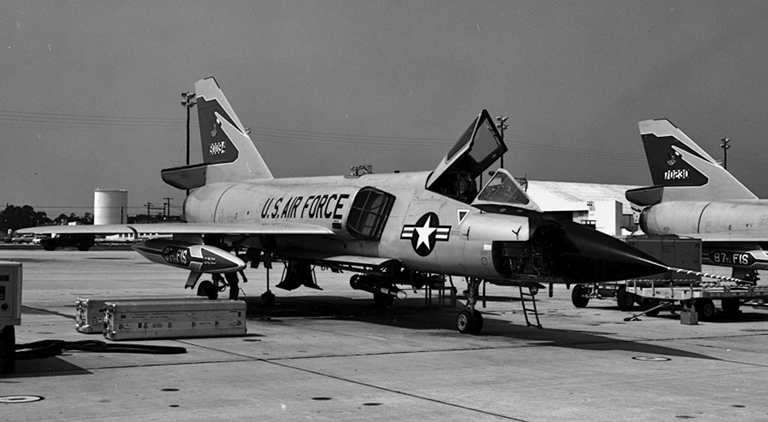 WSEM uploaded onto a
launch rail in the bay of an F-106A (USAF Museum)
Training consisted of mock intercepts against targets simulating incoming Soviet bombers and missile launches. Lockheed T-33s often served as targets for the interceptors, and in some cases expended chaff to evaluate crew and FCS performance in a non-cooperative environment. Crews conducted missile launches during qualification and as part of annual William Tell weapons competitions. Unusual RolesAlthough designed as a weapon to intercept strategic bombers, Falcon missile variants found themselves evaluated or expended in a variety of test programs. These programs included evaluation of the missiles and FCSs for new roles, and evaluating defensive systems.In the late 1960s, the USAF evaluated the AN/ASG-18 and AIM-47A in an anti-missile capacity. The test program involved at least one YF-12A, operating from Edwards AFB at the time, tracking Minuteman ICBMs fired from Vandenberg AFB in California. The AN/ASG-18 proved capable of detecting and tracking the ICBM during its boost phase, and theoretically could have guided AIM-47A rounds to intercept. Falcon missiles returned to the anti-missile role in the early 1970s. The Air Defense Weapons Center at Tyndall AFB, Florida evaluated the F-106A in an anti-missile capacity employing GAR-4A missiles and Genie rockets. BOMARC SAMs simulated ballistic targets, with the GAR-4A and Genie both recording successful intercepts at altitudes of up to 71,500 feet. The GAR-4A returned to the test inventory in the early 1990s. During an unusual test, an F-15 engaged a C-141 over the Eglin AFB range in Florida with four GAR-4As. The F-15 launched the GAR-4As outside of their effective range to evaluate the Starlifter’s Missile Approach Warning System (MAWS). The purpose of the test was to evaluate the ability of the MAWS to detect an incoming missile and activate countermeasures systems. EpilogueWhile never operationally employed in its design role, the Falcon missile and its associated FCSs furthered USAF guided armament development a great deal during the 1950s and 1960s, introducing such advanced features as HOJ capability and automated intercept. While never adopted for additional roles, the Falcon/FCS combination ultimately proved to be a versatile weapon system. |
||||||||||||||||||||||||||||||||||||||||||||||||||||||||||||||||||||||||||||||||||||||||||||||||||||||||||||||||||||||||||||||||||||||||||||||||||||||||||||||||||||||||||||||||||||||||||||||||||||||||||||||||||||||||||||||||||||||||||||||||||||||||||||||||||||||||||||||||||||||||||||||||||||||||||||||||||||||||||||||||||||||||||||||||||||||||||||||||||||||||||||||||||||||||||||||||||||||||||||||||||||||||||||||||||||||||||||||||||||||||||||||||||||||||||||||||||||||||||||||||||||||||||||||||||||||||||||||||||||||||||||||||||||||||||||||||||||||||||||||||||||||||||||||||||||||||||||||||||||||||||||||||||||||||||||||||||||||||||||||||||||||||||||||||||||||||||||||||||||||||||||||||||||||||||||||||||||||||||||||
X. Falcons at War |
||||||||||||||||||||||||||||||||||||||||||||||||||||||||||||||||||||||||||||||||||||||||||||||||||||||||||||||||||||||||||||||||||||||||||||||||||||||||||||||||||||||||||||||||||||||||||||||||||||||||||||||||||||||||||||||||||||||||||||||||||||||||||||||||||||||||||||||||||||||||||||||||||||||||||||||||||||||||||||||||||||||||||||||||||||||||||||||||||||||||||||||||||||||||||||||||||||||||||||||||||||||||||||||||||||||||||||||||||||||||||||||||||||||||||||||||||||||||||||||||||||||||||||||||||||||||||||||||||||||||||||||||||||||||||||||||||||||||||||||||||||||||||||||||||||||||||||||||||||||||||||||||||||||||||||||||||||||||||||||||||||||||||||||||||||||||||||||||||||||||||||||||||||||||||||||||||||||||||||||
The Falcon Goes To WarThe combat history of the Falcon missile does not begin with the often-repeated accounting of its perceived failures as an AAM for the new F-4D. When the F-4Ds first arrived in Vietnam in May of 1967, another group of aviators was already versed in using the Falcon in combat. For a brief period, the Falcon found an unusual niche … as an air-to-ground weapon.Project STOVE PIPEThe Falcon missile arrived on-scene in Southeast Asia during August of 1961. At this time, F-102As from the 509th FIS resided at Clark AFB in the Philippines, and a detachment deployed to Don Muang Airport near Bangkok, Thailand, to provide air defense during the initial hostilities. From 1962 to 1964, 509th FIS F-102As deployed to South Vietnam on various occasions to provide air defense of the nation in anticipation of incursions by the North Vietnamese Air Force (NVAF). These F-102As served as alert interceptors, authorized to engage any NVAF aircraft intruding into South Vietnamese airspace.Beginning in August of 1964, F-102As from the 509th FIS and the Okinawa-based 16th FIS arrived at Da Nang and Tan Son Nhut airbases respectively to begin a long-term F-102A presence in the region. At various times, F-102As from the Clark-based 64th FIS and the Okinawa-based 82nd FIS would also deploy to the region. The F-102A maintained a presence in South Vietnam until 1970. F-102A operations in South Vietnam primarily consisted of sitting alert to protect airbases from NVAF attack. However, during the second half of 1965, Project STOVE PIPE demonstrated that the USAF was willing to do anything to stem the flow of resources along the Ho Chi Minh trail. STOVE PIPE involved the use of Tan Son Nhut-based 509th FIS F-102As against ground targets. Employing their IR seekers, F-102As sought out targets along the Ho Chi Minh Trail, engaging them with IR-guided AIM-4D Falcon missiles and 2.75-inch rockets. If they detected a sufficient radar return, the F-102s also employed SARH-guided Falcons. Because of the nature of Project STOVE PIPE, primarily due to the night engagements, it was often difficult to ascertain if the efforts were having any measurable effect on North Vietnamese resupply efforts. On some occasions, immediate success was evident due to the observation of secondary explosions. One particular sortie saw a North Vietnamese munitions dump struck by Falcon missiles. Secondary explosions continued at the facility for two days, obliterating the supply cache. Despite these efforts, however, Project STOVE PIPE did not significantly manage to stem the flow of material along the Ho Chi Minh Trail. Following Project STOVE PIPE, F-102As operations in South Vietnam returned to air combat. Duties included sitting alert, escorting various military formations, and escorting VIP and commercial flights in the theater. On February 3, 1968, 509th FIS F-102As escorting a group of EW aircraft over Laos participated in the Deuce’s only air combat engagement of the war. A pair of NVAF MiG-21s engaged the F-102As, shooting down 1st Lieutenant Wallace Wiggins in the process with an R-3 (AA-2 ATOLL) AAM. Captain Allen Lomax proceeded to engage one of the MiG-21s with three AIM-4Ds, but the separation was too great for a successful engagement of the departing target. Misses…and MissesWhile the air-to-ground efforts proved to be interesting, the F-102A was an interceptor by design, best suited for air combat. Ultimately, however, the F-102A and its Falcon missiles left Vietnam credited with a single air-to-air engagement resulting in no MiG kills. The anticipated threat of NVAF air raids simply never materialized, leaving the F-102A largely out of the fight apart from select operations. For the Falcon missile to be truly tested in combat, a different platform would be required, one which would spend a fair amount of time engaging the NVAF.In May of 1967, the F-4D began to arrive in Vietnam. At this point, the F-4D relied on the AIM-4D as its short-range AAM, with the AIM-7 serving as its primary BVR armament. The first F-4Ds in theater operated out of Ubon AB in Thailand, assigned to the 555th TFS, 8th TFW. The AIM-4D’s first combat employment with the F-4D occurred on 2 June 1967. A four-ship of 555th TFS Phantom IIs, composed of two F-4Cs carrying AIM-9s and two F-4Ds carrying AIM-4Ds, engaged a number of MiG-17s while escorting a flight of F-105s near Kep. While flying west at 8,000 feet, a flight of MiG-17s was noted passing underneath the fighters. The MiGs were heading north, breaking into a hard left turn. The Phantoms split into two elements of one F-4C and one F-4D to engage the MiG-17s, with the F-4Ds flying lead for each element. The lead F-4D from the first element expended two AIM-4Ds during the engagement. The lead F-4D fired its first AIM-4D in pursuit from a lead angle of 50-60 degrees, flying at 620 KTAS and 1000-1500 feet AGL, with the target in a hard left turn. The F-4D had to maneuver to evade both AAA fire from the ground and four more MiGs on a head-on intercept course, but observed a fireball roughly one mile away after turning to reengage. The lead F-4D fired a second AIM-4D at a MiG-17 attempting to engage its wingman a short time later. This AIM-4D, fired in a head-on aspect under roughly the same flight conditions as the previous shot, passed 15 feet under the MiG-17 without detonating. The AIM-4D’s first combat engagement with the F-4D did not result in any official kills being credited, although the first missile launched appears to have possibly destroyed a MiG-17. Four AIM-7 and three AIM-9 missiles fired by the formation failed to result in any kills as well. The engagement highlighted one of the problems that would plague F-4D crews attempting to employ the weapon. Two AIM-4Ds ran out of coolant while on their launch rails, rendering the missiles useless. On 3 June, the F-4D carried the AIM-4D into combat again on a second escort mission similar to the 2 June event. The F-4C and F-4D formation encountered MiG-17s again, but expended no AIM-4Ds during the engagement. The Phantoms expended three AIM-7s and one AIM-9, but did not score any kills. Two 5 June missions saw the F-4Ds next attempts at using the AIM-4D in combat. The first mission involved a mixed formation of two F-4Cs and two F-4Ds providing MiGCAP for an IRON HAND SEAD mission near Thud Ridge. A flight of MiG-17s jumped the trailing element of one F-4C and one F-4D. In the ensuing engagement, the F-4D fired an AIM-4D and an AIM-7, with the F-4C employing an AIM-7. None of the missiles scored kills on their targets. Meanwhile, the lead F-4C/D pair engaged a wagon-wheel formation of MiG-17s. The lead F-4D initially fired a single AIM-4D head-on at a MiG-17. The AIM-4D did not guide, nor did an AIM-7 fired during a second pass. A third pass resulted in an AIM-7 kill. The second 5 June mission involved another mixed formation of two F-4Cs and two F-4Ds, this time performing MiGCAP for strikes on a JCS target. While covering the egress of the strike package from the target area, the flight received word that a fight was brewing. The flight split into mixed pairs with F-4Ds in the lead positions and went on the hunt. Entering the area in question, the formation came upon four MiG-17s engaged with two F-4Cs. Single MiG-17s orbited above the furball at 3 o’clock and 9 o’clock. The lead element of one F-4C and one F-4D engaged the solitary MiG-17 at 9 o’clock, with the second element engaging the other observer. The first element succeeded in downing its MiG-17, but it took some effort to do so. Initially, the lead F-4D fired two AIM-4Ds, of which one failed to guide and a second was not observed doing anything productive at all, having remained on the launch rail. The pilot switched weapons and fired four AIM-7s at the MiG-17, with none of the missiles guiding properly. After reengagement, the F-4C fired two AIM-9s at the MiG-17, hitting the target’s tail and knocking it out of the sky for a confirmed kill. The second element did not turn out to be as fortunate as the first. The lead F-4D attempted to launch four AIM-4Ds, one of which failed to leave the rail. The three AIM-4Ds that did successfully launch all missed the MiG-17 by distances of 20 feet, 10 feet, and 10 feet respectively. At this point, the AIM-4D began to build a less than stellar reputation among F-4D units. By the end of August, F-4D crews had attempted to fire twenty-five AIM-4Ds, with seven missiles failing to leave the launch rail. Of the eighteen missiles actually launched, none scored hits with the possible exception of the first missile fired on 2 June, although near misses were common. To be fair, the missions described above also saw six AIM-9s and fifteen AIM-7s fired, with only a single kill scored by each weapon. If the AIM-4D was not living up to expectations, neither was anything else. A good portion of the anti-Falcon sentiment came from a single man, Col. Robin Olds, commander of Ubon’s 8th TFW. Col. Olds was the lead F-4D pilot on the 2 June mission and the second 5 June mission, having fired three AIM-4Ds with a fourth aborting on the rail. Col. Olds became so disenfranchised with the performance of the AIM-4D that he ordered his 8th TFW ground crews to retrofit the unit’s F-4Ds with AIM-9 capability, something which would not be “officially” included in the F-4D’s armament suite until 1969. These efforts ended in late 1967; Col. Olds left the theater in September and Seventh Air Force directed the unit to halt AIM-9 modifications. AIM-4D SuccessThe AIM-4D finally achieved a confirmed kill in late 1967. On 26 October, a flight of four F-4Ds, Ford flight, escorted two RF-4Cs on a reconnaissance mission near Phuc Yen AB and encountered six MiG-17s. Ford 03 fired an AIM-4D at a MiG-17 in a head-on pass, but was unable to observe the missile’s performance as the pilot broke off to avoid another incoming MiG-17. The crew observed a parachute in the area of the potential intercept, but could not confirm an AIM-4D kill.Ford 04, acting as Ford 03’s wingman during the engagement, had far better luck, firing an AIM-4D at a range of 6,000 feet in a tail-chase engagement of an additional MiG-17. This time, the crew watched as the AIM-4D flew directly up the MiG-17’s jetpipe and detonated. The NVAF pilot ejected for the AIM-4D’s first confirmed kill. The AIM-4D would go on to score three additional confirmed kills in early 1968. AIM-4Ds destroyed MiG-21s on 3 January and 5 February, with a MiG-17 kill occurring on 8 January. With the cessation of Operation ROLLING THUNDER on 1 April, the AIM-4D lost any chance of improving its reputation. Further use in combat may have resulted in a greater success rate, as the 8th TFW received 274 extended-cooling AIM-4Ds around this time. By the time the air war resumed in earnest in 1972, the F-4D possessed AIM-9 capability, replacing the AIM-4D. The AIM-4D remained on hand with F-4D units until earlier in 1972, however, formally withdrawn from the theater on 22 April. Number CrunchingDue to its lack of success, the USAF perceived the AIM-4D as a failure in Vietnam. Between the F-4D and F-102A, crews attempted to launch 51 AIM-4Ds at MiGs. Seven of these missiles failed to leave their launch rail altogether, with only five scoring confirmed kills for a success rate of only 9.8%. The kill ratio improves marginally to 13.7% if the two unconfirmed kills count as successes.While the AIM-4D’s official 9.8% kill ratio seems horrendous, it was not markedly worse than other AAMs employed during the Vietnam War. Out of over six hundred AIM-7s fired over Vietnam, the weapon only scored 56 kills, for a kill ratio of 9.2%. The AIM-9 performed better, with a kill ratio just under 20%, but neither missile was by far a more reliable option than the AIM-4D, with the AIM-7 actually turning out to be a mathematically less reliable weapon system. The AIM-7 kill ratio is skewed due to pilots often preferring to ripple-fire at least two AIM-7s per target to increase the kill probability, but if the number of weapons launched is halved a kill ratio of only 18.3% is achieved. However, if the missile’s effectiveness reflected such a figure, constant use of ripple-firing tactics would not have been necessary. Ultimately, the AIM-4D proved to be ineffective over Vietnam for multiple reasons. The most obvious reason lay in the design of the missile. The AIM-4D represented a modified AIM-4 intended to counter maneuverable targets, including fighter aircraft. As a relatively basic modification, primarily involving the IR seeker, the AIM-4D retained numerous Falcon features precluding it from enjoying more success and a better reputation over Vietnam. Foremost among these features was the presence of a contact fuse. Both the AIM-7 and AIM-9 enjoyed the advantages of a proximity fuse, which alleviated the requirement for a direct hit to initiate warhead detonation. The presence of a proximity fuse on the AIM-4D may have resulted in at least two more kills, pushing the kill ratio to a theoretical maximum of 18.4%, accounting for the two possible kills and the retention of two missiles launched following a near miss. Another reason for the failure of the AIM-4D related directly to aircrew training. While stateside F-4D crews trained in the classroom and followed this with captive-carry flights and a missile firing, crews in Vietnam only received a slideshow presentation illustrating how to employ the AIM-4D. This lack of training on the new weapon system likely contributed to the USAF’s finding that pilots launched over half of the AIM-4Ds expended outside of the stated performance envelope. Returning to the numbers, F-4D crews attempted to fire 48 AIM-4Ds, of which 41 managed to leave the rail. If 20 of these launches took place outside textbook parameters, and the five kills took place within those parameters, the missile’s kill ratio improves to between 16.1% and 22.6%, depending on whether the possible kills are included. Both figures place the AIM-4D in a far different light, and the latter figure would represent the best-performing AAM of the entire war. The modified IR seeker provided another headache for F-4D pilots unaccustomed to employing the weapon. The AIM-4D’s cooled IR seeker employed liquid nitrogen to achieve the necessary level of sensitivity, but the F-4D only contained enough liquid nitrogen to cool the seeker head for a total of two minutes. Furthermore, once the cooling sequence began prior to launch, the missile became useless if not fired within those two minutes. Regardless of the interpretation of the performance figures, the AIM-4D did not perform markedly better or worse than other AAMs over Vietnam. The most likely culprit behind the dislike of the AIM-4D, apart from the complex launch procedures, stems from the fact that the USAF intended the missile to be its new air combat weapon. When the AIM-4D arrived in Vietnam and did not live up to this billing by outperforming other AAMs already in use, pilots had no other logical course of action but to be disenfranchised with the weapon’s performance. CyprusThe airspace above the Aegean Sea and the Eastern Mediterranean proved to be volatile at times during the Cold War. The Turkish invasion of Cyprus on 20 July 1974 sparked a series of events including various air combat engagements. A variety of sources describe numerous alleged air combat incidents, but conflicting accounts and a lack of credible third-party confirmation make these events difficult to analyze.One such air combat incident took place on 22 July. On this date, a Turkish F-102A belonging to 142 Filo reportedly downed a Greek F-5A from 111 Pterix Mahis. According to Turkish reports regarding the event, the engagement proceeded as follows. A pair of Turkish Delta Daggers encountered a pair of Greek F-5As while on an intercept mission. Upon closing with the Greek fighters, one of the F-5As fired an AIM-9, missing the Turkish F-102As. The F-102As reversed course to take up a trailing position, at which point one aircraft fired a single AIM-4D, destroying a Greek F-5A in the process. As neither Greek nor Turkish accounts of the events on 22 July can be reconciled with each other, with each side often claiming aircraft losses due to “fuel starvation”, for example, the incident cannot conclusively be proven to have occurred the way it is depicted in Turkish reporting. However, given the presence of the F-102A in the Cypriot theater of operations, the possibility of an AIM-4D kill remains until disproven. As reported, it stands as the last Falcon air-to-air combat kill. EpilogueFortunately for all concerned, the Falcon missile never saw combat in its intended role against nuclear bombers. However, the intended role that drove the design of the missile ultimately led to a general lack of success over Vietnam. In hindsight, the AIM-4D’s kill ratio of 11.5%, including the Turkish kill, did not leave the missile with a statistical performance fitting its reputation as a relatively useless weapon. AAM performance has not markedly improved since Vietnam with the AIM-7 and AIM-9 logging kill ratios of 28% and 14% over Iraq in 1991. Historically speaking, a weapon designed in the 1950s for one role achieving a kill ratio of nearly 12% in a different role during the 1960s and 1970s is not indicative of a useless weapon, especially when considering that it statistically outperformed at least one other AAM over Vietnam. |
||||||||||||||||||||||||||||||||||||||||||||||||||||||||||||||||||||||||||||||||||||||||||||||||||||||||||||||||||||||||||||||||||||||||||||||||||||||||||||||||||||||||||||||||||||||||||||||||||||||||||||||||||||||||||||||||||||||||||||||||||||||||||||||||||||||||||||||||||||||||||||||||||||||||||||||||||||||||||||||||||||||||||||||||||||||||||||||||||||||||||||||||||||||||||||||||||||||||||||||||||||||||||||||||||||||||||||||||||||||||||||||||||||||||||||||||||||||||||||||||||||||||||||||||||||||||||||||||||||||||||||||||||||||||||||||||||||||||||||||||||||||||||||||||||||||||||||||||||||||||||||||||||||||||||||||||||||||||||||||||||||||||||||||||||||||||||||||||||||||||||||||||||||||||||||||||||||||||||||||
XI. Conclusion |
||||||||||||||||||||||||||||||||||||||||||||||||||||||||||||||||||||||||||||||||||||||||||||||||||||||||||||||||||||||||||||||||||||||||||||||||||||||||||||||||||||||||||||||||||||||||||||||||||||||||||||||||||||||||||||||||||||||||||||||||||||||||||||||||||||||||||||||||||||||||||||||||||||||||||||||||||||||||||||||||||||||||||||||||||||||||||||||||||||||||||||||||||||||||||||||||||||||||||||||||||||||||||||||||||||||||||||||||||||||||||||||||||||||||||||||||||||||||||||||||||||||||||||||||||||||||||||||||||||||||||||||||||||||||||||||||||||||||||||||||||||||||||||||||||||||||||||||||||||||||||||||||||||||||||||||||||||||||||||||||||||||||||||||||||||||||||||||||||||||||||||||||||||||||||||||||||||||||||||||
An Evolving FamilyWhile never adopted beyond the USAF in American service, the Falcon missile’s aerodynamic planform left a lasting legacy on various Hughes products. The AGM-65 Maverick AGM, AIM-54 Phoenix AAM, and AGM-142 Wasp AGM all incorporated the Falcon’s delta-wing planform. Furthermore, the AN/ASG-18 and GAR-9 combination served as starting points for the development of the US Navy’s AWG-9 FCS and AIM-54 missile system, serving in a fleet defense capability onboard the F-14 Tomcat from 1974 to 2004. The AGM-65 remains in service with American and foreign air arms around the globe, ensuring that the Falcon’s legacy will continue into the 21st Century.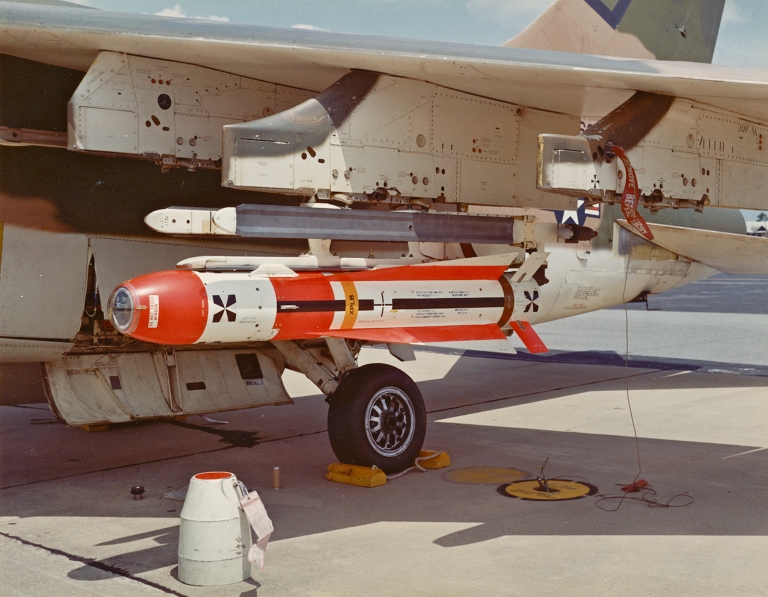 AGM-65A test round on A-7D illustrating the retention of the Falcon missile planform (USAF via Ryan Crierie) 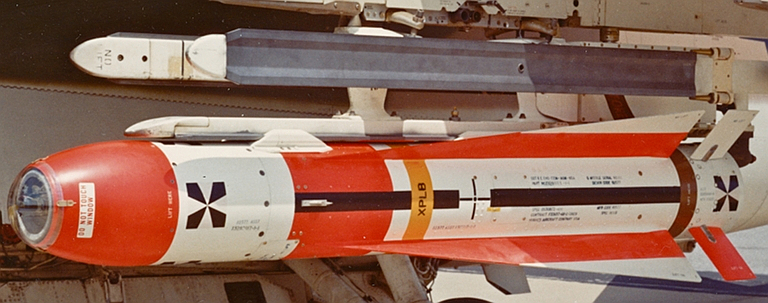 As the first guided AAM to reach operational service in the USAF, the Falcon missile allowed America’s interceptors to enter the Missile Age. Numerous variants displayed increasing capability and brought new features to the family, ensuring that America’s interceptors possessed the capability to defend American and Canadian skies from the Soviet bomber threat. When the USAF retired the final Falcon missiles from the operational inventory in 1988, the weapon completed a 32-year career defending North American airspace. Despite development problems, shortcomings in Vietnam, and a constantly evolving design, the Falcon missile family has earned its place in Cold War history. |
||||||||||||||||||||||||||||||||||||||||||||||||||||||||||||||||||||||||||||||||||||||||||||||||||||||||||||||||||||||||||||||||||||||||||||||||||||||||||||||||||||||||||||||||||||||||||||||||||||||||||||||||||||||||||||||||||||||||||||||||||||||||||||||||||||||||||||||||||||||||||||||||||||||||||||||||||||||||||||||||||||||||||||||||||||||||||||||||||||||||||||||||||||||||||||||||||||||||||||||||||||||||||||||||||||||||||||||||||||||||||||||||||||||||||||||||||||||||||||||||||||||||||||||||||||||||||||||||||||||||||||||||||||||||||||||||||||||||||||||||||||||||||||||||||||||||||||||||||||||||||||||||||||||||||||||||||||||||||||||||||||||||||||||||||||||||||||||||||||||||||||||||||||||||||||||||||||||||||||||
Annex A - Data |
||||||||||||||||||||||||||||||||||||||||||||||||||||||||||||||||||||||||||||||||||||||||||||||||||||||||||||||||||||||||||||||||||||||||||||||||||||||||||||||||||||||||||||||||||||||||||||||||||||||||||||||||||||||||||||||||||||||||||||||||||||||||||||||||||||||||||||||||||||||||||||||||||||||||||||||||||||||||||||||||||||||||||||||||||||||||||||||||||||||||||||||||||||||||||||||||||||||||||||||||||||||||||||||||||||||||||||||||||||||||||||||||||||||||||||||||||||||||||||||||||||||||||||||||||||||||||||||||||||||||||||||||||||||||||||||||||||||||||||||||||||||||||||||||||||||||||||||||||||||||||||||||||||||||||||||||||||||||||||||||||||||||||||||||||||||||||||||||||||||||||||||||||||||||||||||||||||||||||||||
A1.1 Falcon Missile Designations
A1.2 Falcon Missile DimensionsAll dimensions are in inches, weight figures are in pounds
(2) Proposed dual-seeker variant A1.3 Falcon Missile Warhead DataWeight figures are in pounds; Total Weight includes triggering and fusing systems
(2) As built, AIM-47A (3) Continuous-rod High Explosive A1.4 Falcon Missile Guidance and Propulsion SystemsIR bands are in microns, FCS preparation times are in seconds
(2) Proposed IR guided variant (3) As built, AIM-47A A1.5 Falcon Missile Performance DataOptimum range and altitude figures are in feet, maximum range figures are in given units, flight time figures are in seconds
(2) As built, AIM-47A A1.6 Scale Illustrations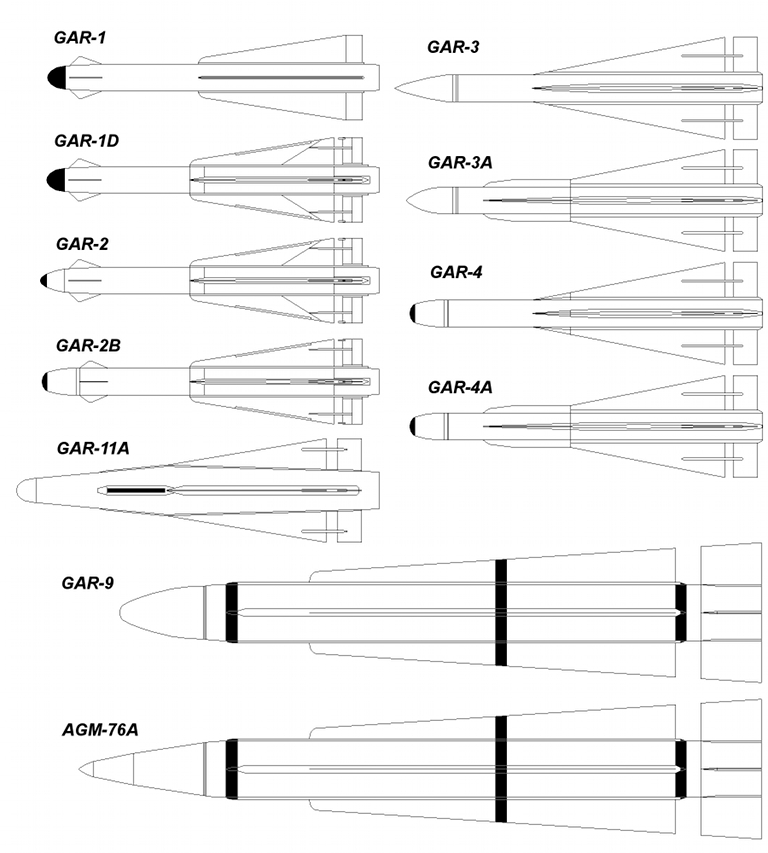 Major
Falcon missile variants drawn to scale (Sean O’Connor)
|
||||||||||||||||||||||||||||||||||||||||||||||||||||||||||||||||||||||||||||||||||||||||||||||||||||||||||||||||||||||||||||||||||||||||||||||||||||||||||||||||||||||||||||||||||||||||||||||||||||||||||||||||||||||||||||||||||||||||||||||||||||||||||||||||||||||||||||||||||||||||||||||||||||||||||||||||||||||||||||||||||||||||||||||||||||||||||||||||||||||||||||||||||||||||||||||||||||||||||||||||||||||||||||||||||||||||||||||||||||||||||||||||||||||||||||||||||||||||||||||||||||||||||||||||||||||||||||||||||||||||||||||||||||||||||||||||||||||||||||||||||||||||||||||||||||||||||||||||||||||||||||||||||||||||||||||||||||||||||||||||||||||||||||||||||||||||||||||||||||||||||||||||||||||||||||||||||||||||||||||
Annex B - Users |
||||||||||||||||||||||||||||||||||||||||||||||||||||||||||||||||||||||||||||||||||||||||||||||||||||||||||||||||||||||||||||||||||||||||||||||||||||||||||||||||||||||||||||||||||||||||||||||||||||||||||||||||||||||||||||||||||||||||||||||||||||||||||||||||||||||||||||||||||||||||||||||||||||||||||||||||||||||||||||||||||||||||||||||||||||||||||||||||||||||||||||||||||||||||||||||||||||||||||||||||||||||||||||||||||||||||||||||||||||||||||||||||||||||||||||||||||||||||||||||||||||||||||||||||||||||||||||||||||||||||||||||||||||||||||||||||||||||||||||||||||||||||||||||||||||||||||||||||||||||||||||||||||||||||||||||||||||||||||||||||||||||||||||||||||||||||||||||||||||||||||||||||||||||||||||||||||||||||||||||
United States Air ForceOperational: AIM-4/-4A/-4B/-4C/-4D/-4E/-4F/-4G/-26A/-26B; the GAR-1B may have been operational for a limited time. Test Only: AIM-4H, AIM-47A, AGM-76A CanadaAIM-4D Canada purchased the AIM-4D in the 1960s to arm its CF-101B Voodoo interceptors. Given that the aircraft entered service in 1961, the CF-101B/F likely employed earlier Falcon variants for at least a brief period as the AIM-4D became operational in 1963. FinlandRb.27, Rb.28 Finland received Rb.27 and Rb.28 missiles from Sweden between 1972 and 1976 to arm its Draken fighters. GreeceAIM-4D Greece received Falcon missiles in the late 1960s to arm its F-102A interceptors. Possession of other Falcon variants is unknown at this time. IranAIM-4D Iran took delivery of 400 AIM-4Ds between 1968 and 1969 to arm its F-4D. As Iranian F-4Ds did not use the AIM-4D during the Iran-Iraq War of the 1980s, the weapon likely did not remain in service with the Iranian Air Force for an extended period. JapanAIM-4D Japan employed the AIM-4D on the F-4EJ until the indigenous AAM-2 was available. 130 AIM-4Ds were delivered between 1971 and 1972. Interestingly, F-4EJs were seen equipped with the distinctive AIM-4D launch rails into the 1990s. SwitzerlandHM-55 Switzerland ordered 225 HM-55s in 1961; the missiles arrived between 1965 and 1968. SwedenRb.27, Rb.28 Sweden contracted with Hughes to license build the HM-55 and HM-58 as the Rb.27 and Rb.28. TurkeyTurkey acquired Falcon missiles to arm F-102 interceptors imported in the late 1960s. The specific variants acquired remain undetermined, but the period in which the aircraft arrived would seem to indicate that the AIM-4D was among any variants received. This is borne out by Turkey claiming an AIM-4D kill in 1974. TaiwanAIM-4D Taiwan appears as
a former Falcon
user in various sources, although no solid evidence of ROCAF Falcon
use exists. It is possible that USAF F-4D units deployed to Taiwan
employed the AIM-4D, leading to the confusion. Alternatively, F-4D
units may have left the weapons in Taiwan following its
discontinuation as Phantom II armament. Regardless, Taiwan would not
have been able to employ the AIM-4D on its own aircraft, as it lacked
a suitable carrier with the required avionics or pylons. |
||||||||||||||||||||||||||||||||||||||||||||||||||||||||||||||||||||||||||||||||||||||||||||||||||||||||||||||||||||||||||||||||||||||||||||||||||||||||||||||||||||||||||||||||||||||||||||||||||||||||||||||||||||||||||||||||||||||||||||||||||||||||||||||||||||||||||||||||||||||||||||||||||||||||||||||||||||||||||||||||||||||||||||||||||||||||||||||||||||||||||||||||||||||||||||||||||||||||||||||||||||||||||||||||||||||||||||||||||||||||||||||||||||||||||||||||||||||||||||||||||||||||||||||||||||||||||||||||||||||||||||||||||||||||||||||||||||||||||||||||||||||||||||||||||||||||||||||||||||||||||||||||||||||||||||||||||||||||||||||||||||||||||||||||||||||||||||||||||||||||||||||||||||||||||||||||||||||||||||||
Annex C - Launch Platforms |
||||||||||||||||||||||||||||||||||||||||||||||||||||||||||||||||||||||||||||||||||||||||||||||||||||||||||||||||||||||||||||||||||||||||||||||||||||||||||||||||||||||||||||||||||||||||||||||||||||||||||||||||||||||||||||||||||||||||||||||||||||||||||||||||||||||||||||||||||||||||||||||||||||||||||||||||||||||||||||||||||||||||||||||||||||||||||||||||||||||||||||||||||||||||||||||||||||||||||||||||||||||||||||||||||||||||||||||||||||||||||||||||||||||||||||||||||||||||||||||||||||||||||||||||||||||||||||||||||||||||||||||||||||||||||||||||||||||||||||||||||||||||||||||||||||||||||||||||||||||||||||||||||||||||||||||||||||||||||||||||||||||||||||||||||||||||||||||||||||||||||||||||||||||||||||||||||||||||||||||
C.1 Operational UsersNorthrop F-89HWeapon: 6 x AIM-4/-4A/-4B Carriage: the F-89H employed wingtip pods for armament carriage. These pods contained FFAR tubes, as well as individual bays and launch rails for three Falcon-series missiles each. A typical loadout consisted of three AIM-4A and three AIM-4B missiles, with each pod containing a separate Falcon variant. F-89H weapons pod illustration depicting GAR-2 Falcon carriage (USAF via Ryan Crierie) Northrop F-89JWeapon: 4 x AIM-4C Carriage: the F-89J featured two pylons under each wing for AIM-4C carriage. The pylons were inboard of the AIR-2 Genie stations, and were staggered vertically with the inner pair of Falcons carried on deeper pylons than the outer pair. Problems with external carriage of the AIM-4C resulted in the removal of their pylons from operational F-89Js, leaving them with the AIR-2A as their only armament. Illustration depicting
the F-89J’s staggered AIM-4C carriage (USAF via Ryan Crierie)
McDonnell F-101B/F (early)Weapon: 6 x AIM-4/-4A/-4B/-4C Carriage: a rotary pallet contained the weapons for the F-101B/F. The early pallet contained three extendable Falcon launch rails on one side, with three fixed launch rails on the opposite side. In flight, exposure of the side with extendable rails allowed carriage of the missiles in a low-drag, conformal arrangement. Extendable rails were not required on the opposite side, with these weapons only exposed for launch. Three IR and three SARH weapons comprised a common loadout. USAF references indicate that the original six Falcon loadout remained an option during the F-101B/F’s career, although it was rarely if ever used as the pallet was replaced during modifications to employ the AIR-2. Illustration depicting the six Falcon pallet design for the F-101B/F (USAF via Ryan Crierie) McDonnell F-101B/F (late)Weapon: 2 x AIM-4A/-4C/-4D Carriage: beginning in 1961, modification of the F-101B/F to carry and launch the AIR-2 Genie nuclear rocket resulted in the introduction of a new weapons pallet. This pallet contained attachment points for two AIR-2 rockets on one side, and extendable launch rails for two AIM-4D missiles on the opposite side. Operational aircraft typically employed the AIM-4D, indicating that the earlier Falcon variants did not remain commonly used. F-101B cutaway
depicting the weapons configuration when employing the AIR-2 (USAF
via Ryan Crierie)
McDonnell CF-101B/FWeapon: 2 x AIM-4D Carriage: identical to the USAF’s F-101B/F (late). Convair F-102Weapon: 6 x AIM-4/-4A/-4B/-4C/-D, or 4 x AIM-4 series and 2 x AIM-26A/-26B Carriage: the F-102 featured three separate side-by-side weapons bays along the centerline, each capable of carrying two AIM-4 series missiles. Separate fore and aft trapeze launchers located in each bay extended to fire the missiles. Aircraft modified to employ the AIM-26 series featured provision to carry and launch these weapons from the centerline bay. A typical late-1950s loadout included three IR guided and three SARH guided Falcons. During Vietnam, a common loadout consisted of one AIM-4A forward and one AIM-4D aft in each side bay, with one AIM-26B forward and one AIM-4D aft in the centerline bay. F-102A weapons bay fitted with the common Vietnam loadout (Sean O’Connor) AIM-4A and AIM-4D shown retracted in the left side weapons bay of an F-102A (Sean O’Connor) Convair F-106Weapon: 4 x AIM-4E/-4F/-4G Carriage: the F-106 featured a weapons bay with the ability to mount four Super Falcon series AAMs. Falcons were carried on launch rails in fore and aft pairs. In the F-106A, a pallet mounted the forward pair of rails, with the aft pair of rails carried on separate trapeze assemblies. The location of the AIR-2 Genie rocket in the weapons bay between the aft pair of Falcons resulted in the aft pair of missiles being located further from the centerline than the forward pair. Avionics relocation in the F-106B resulted in replacement of the pallet with separate trapeze assemblies for each of the forward launch rails. A typical loadout consisted of two AIM-4F and two AIM-4G missiles, although four missiles of a single type could be fitted if desired. In the typical configuration, the forward rails mounted the AIM-4F and the rear rails mounted the AIM-4G. When engaging a target with all four weapons, the rear pair of AIM-4Gs launched first to ensure that the IR seeker heads would not simply lock on to the rocket motors of the AIM-4Fs. Otherwise, the Falcons launched in like pairs, enabling the F-106 to engage two targets with AAMs per sortie. F-106A displaying AIM-4F and AIM-4G missiles on extended launch rails (Sean O’Connor) McDonnell-Douglas F-4C/D/E/EJWeapon: 4 x AIM-4D Carriage: LAU-42/A launch rail assemblies fitted to the inner wing pylons allowed carriage of up to four AIM-4Ds. The inner wing pylon carried one rail on the main pylon itself, with a second rail on the inboard AIM-9 station. The rail mounted on the inboard AIM-9 station was a bulkier assembly than that fitted to the main pylon as it contained the liquid nitrogen supply used to cool the AIM-4D seeker head prior to launch as well as various electronic components. For this reason, it was possible to carry the inboard pair of AIM-4Ds while carrying other external stores on the main pylons, but not possible to carry only the lower pair of Falcons. While often associated solely with the F-4D due to the experiences of the Vietnam War, the AIM-4D was also operational on both the F-4E and F-4EJ, and at least trialed on the F-4C. A USAFE Soesterberg-based F-4E armed with four AIM-4D missiles in September of 1973 (Fred Willemsen) Dassault Mirage IIISWeapon: 2 x HM-55 Carriage: side-by-side rear fuselage pylons mounted near the trailing edge of the wing. Saab J-35F/JWeapon: 2 x Rb.27 and 2 x Rb.28 Carriage: Draken variants capable of employing the Falcon carried up to four missiles. Rail launchers carried Swedish-built Rb.27 and Rb.28 Falcons. Initially, the larger Rb.27 employed two fuselage pylons, with the smaller Rb.28 carried on wing pylons. Later in the Draken’s career, the Rb.24, a license-built AIM-9, replaced the Rb.28. The Draken retained the SARH Rb.27. In this configuration, the Rb.27 typically employed the outer wing pylons formerly occupied by the Rb.28, dispelling the notion that the weapon was too heavy for carriage on those stations. Early J-35Fs sitting alert sometimes employed a loadout of one Rb.27 and one Rb.28 under the wings, with the fuselage stations occupied by fuel tanks. The Swedish AF trialed a loadout of four Rb.27s; it is not known if this configuration was employed operationally. Saab J-37/AJ-37Weapon: 2 x Rb.28 Carriage: while seldom used, Viggens could employ Rb.28s on the outer wing pylons. C.2 Test UsersBoeing B-25Weapon: early GAR-1 models, quantity unknown Carriage: an underwing pylon fitted with a launch rail carried the weapon. Convair B-58AWeapon: 1 x GAR-9/AIM-47A Carriage: a specially designed weapons pod for B-58A 55-665 contained provision for carriage and launch of a single GAR-9. A trapeze launcher carried the weapon. North American F-86DWeapon: 4 x GAR-1B Carriage: two specially fitted pylons under each wing. A single F-86D, serial 53-4061, evaluated the GAR-1B beginning in 1955 as part of an effort to improve the aircraft’s effectiveness. The effort ultimately ended in 1957 without the Falcon missile becoming part of the Sabre’s armament. Northrop F-89DWeapon: GAR-1, quantity unknown Carriage: in 1953 the F-89D trialed the GAR-1 missile with the Scorpion’s E-6 fire control system. Modified wingtip pods contained provision for carrying the Falcon missiles in a manner similar to that employed by the F-89H. The missile did not operationally arm the F-89D despite provisions for carriage being included in the avionics system. Convair F-106AWeapon: AIM-26 Carriage: in the 1970s the F-106 trialed the AIM-26, with the missile being carried underwing using the same pylons developed for the Seekbat AAM trials. This program involved the use of helmet-mounted sights, and consisted of both captive carry flights and target drone engagements. The USAF did not adopt this configuration for service. Lockheed YF-12AWeapon: 3 x AIM-47A Carriage: the YF-12A had four weapon bays located in the chines, fore and aft on either side of the aircraft. The right side forward bay contained avionics equipment, allowing the carriage of three AIM-47As. McDonnell-Douglas F-15Weapon: 4 x AIM-4G Carriage: modified launchers permitted the carriage of two AIM-4Gs under each wing pylon. C.3 Proposed UsersNorth American F-86LWeapon: AIM-4B, quantity unknown Carriage: the proposed launch system is unknown, but likely similar to the method trialed on the F-86D. The USAF examined Falcon employment by the F-86L concurrently with the efforts to employ the GAR-1B on the F-86D. Northrop F-89FWeapon: 8 x Falcons of undisclosed variants Carriage: this Northrop proposal for a heavily modified F-89, dated 1951, featured underwing weapons pods each capable of housing four Falcon-series AAMs. McDonnell F-101AWeapon: 3 x Falcons of undisclosed variants Carriage: in the initial escort fighter role, the proposed F-101A carried three Falcon missiles as part of its armament. Republic F-103 (early)Weapon: 6 x GAR-1A Carriage: the initial XF-103 designs mounted GAR-1A missiles in individual launch bays on the aircraft’s fuselage sides. The missiles launched from extendable rails. F-103 internal
arrangement depicting the placement of GAR-1A missiles (USAF via Ryan
Crierie)
Republic F-103 (late) Weapon: 4 x
GAR-1A, 2 x GAR-X (later
GAR-9) Carriage: the final
XF-103 design featured four GAR-1A missiles mounted in similar
fashion to the early designs, with the addition of two GAR-X weapons
mounted in individual bays along the upper fuselage sides. After
cancellation of the F-103, Hughes suggested this configuration as a
trials platform for the GAR-X and AN/ASG-18 fire control system still
planned for use by the F-108.
Convair F-106-30Weapon: 2 x GAR-9 Carriage: an internal weapons bay provided carriage for two GAR-9 missiles in this 1958 study. North American F-108 Weapon: 3 x GAR-X (later GAR-9) 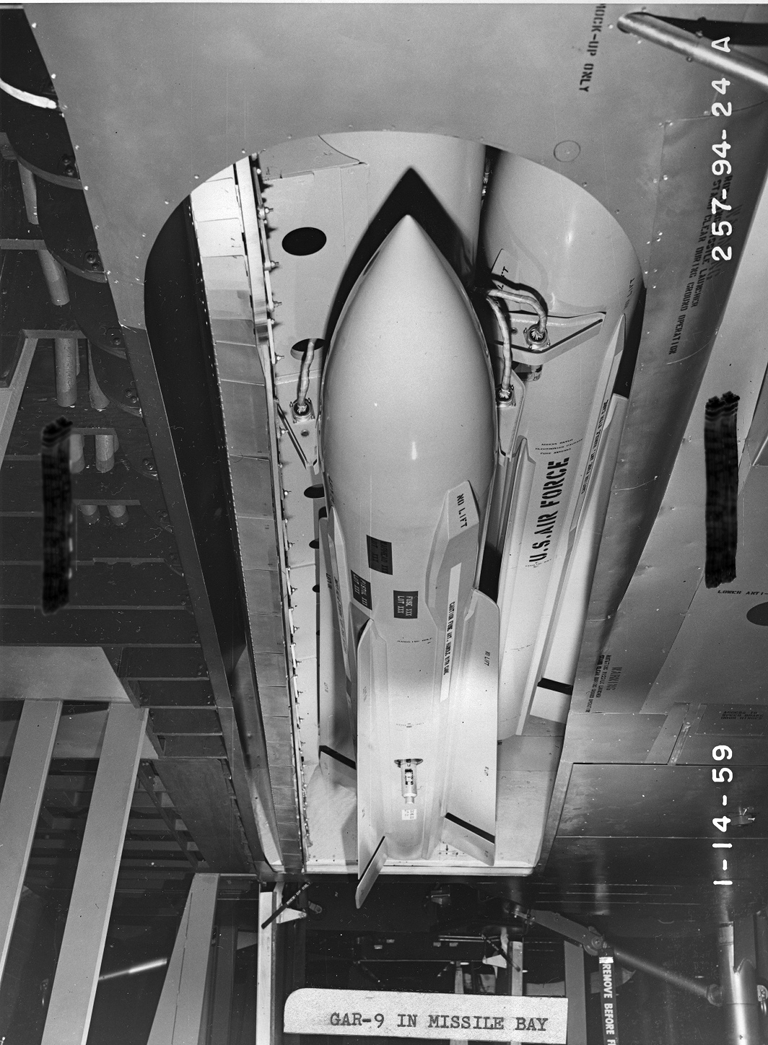 F-108 mockup showing the rotary weapons pallet configuration (National Archives via Dennis R. Jenkins) Carriage: the F-108
featured a unique rotary weapons bay configuration similar to that
found on the F-101B. The weapons bay door rotated along its long
axis to expose the three GAR-X missiles for launch, with one weapon
exposed at a time. A V-shaped assembly fixed to the rotating door
served as the mounting point for the three missiles.
Lockheed F-12BWeapon: 3 x AIM-47B Carriage: as YF-12A 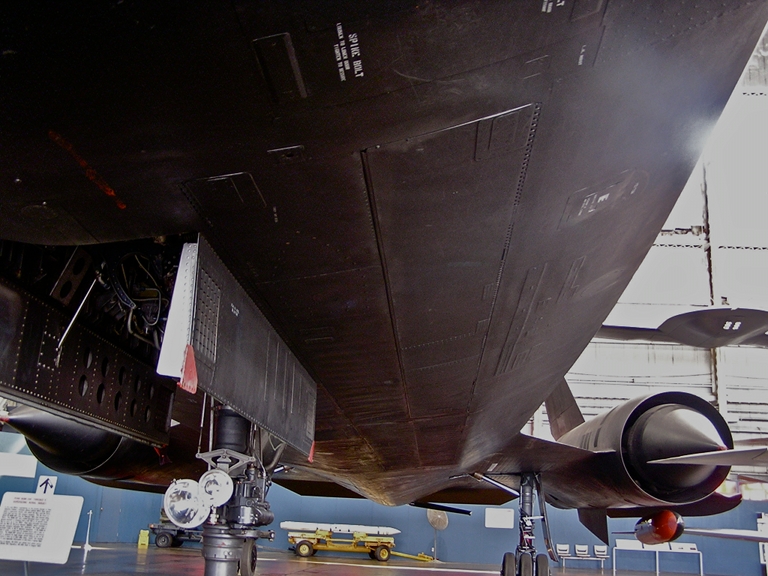 YF-12A
tandem
missile
bays
located
in
the
port
chine;
F-12B bays would
have been similarly arranged (Sean O’Connor)
Lockheed L-205 Weapon: 6 x
Falcons of undisclosed
variants Carriage: an internal
weapons bay provided carriage for six
Falcon-series AAMs in this Lockheed proposal responding to a 1949
USAF request for the “1954 interceptor” which resulted in the
F-102. Many other companies
presented similar airframes, all featuring Falcon missile armament
carried internally.
Avro CF-105Weapon: 8 x GAR-1 Carriage: the
CF-105 featured a
unique removable weapons bay assembly equipped with trapeze
launchers, arranged in two horizontal rows of four each, for eight
GAR-1 missiles. While available weapon system documentation depicts
the early GAR-1 model, it is likely that more advanced versions would
have been incorporated had the CF-105 survived to see production. |
||||||||||||||||||||||||||||||||||||||||||||||||||||||||||||||||||||||||||||||||||||||||||||||||||||||||||||||||||||||||||||||||||||||||||||||||||||||||||||||||||||||||||||||||||||||||||||||||||||||||||||||||||||||||||||||||||||||||||||||||||||||||||||||||||||||||||||||||||||||||||||||||||||||||||||||||||||||||||||||||||||||||||||||||||||||||||||||||||||||||||||||||||||||||||||||||||||||||||||||||||||||||||||||||||||||||||||||||||||||||||||||||||||||||||||||||||||||||||||||||||||||||||||||||||||||||||||||||||||||||||||||||||||||||||||||||||||||||||||||||||||||||||||||||||||||||||||||||||||||||||||||||||||||||||||||||||||||||||||||||||||||||||||||||||||||||||||||||||||||||||||||||||||||||||||||||||||||||||||||
Annex D - Gallery |
||||||||||||||||||||||||||||||||||||||||||||||||||||||||||||||||||||||||||||||||||||||||||||||||||||||||||||||||||||||||||||||||||||||||||||||||||||||||||||||||||||||||||||||||||||||||||||||||||||||||||||||||||||||||||||||||||||||||||||||||||||||||||||||||||||||||||||||||||||||||||||||||||||||||||||||||||||||||||||||||||||||||||||||||||||||||||||||||||||||||||||||||||||||||||||||||||||||||||||||||||||||||||||||||||||||||||||||||||||||||||||||||||||||||||||||||||||||||||||||||||||||||||||||||||||||||||||||||||||||||||||||||||||||||||||||||||||||||||||||||||||||||||||||||||||||||||||||||||||||||||||||||||||||||||||||||||||||||||||||||||||||||||||||||||||||||||||||||||||||||||||||||||||||||||||||||||||||||||||||
D.1 Falcon Missile Internal ArrangementsThe following illustrations depict the internal arrangements of Falcon missile components. GAR-1 internal arrangement (USAF via Ryan Crierie)
GAR-3A
internal
arrangement (USAF via Ryan Crierie)
GAR-11A internal arrangement (USAF via Ryan Crierie) GAR-9 mockup displayed in 1959 opened to depict internal components. Major subassemblies, from left to right: HE warhead, angular rate sensor and control units, electronics unit, umbilical unit, rocket motor (National Archives via Dennis R. Jenkins) D.2 USAF Illustrations 1953 XGAR-1A concept (USAF via Ryan Crierie) 1954 XGAR-1A concept, bearing resemblance to the eventual GAR-3 configuration (USAF via Ryan Crierie) D.3 Falcons in Service F-106A displayed with a complete weapons load consisting of two GAR-3A and two GAR-4A missiles and a single Genie nuclear rocket (USAF Museum) D.4 Falcons on Display F-106A on display at the USAF Museum armed with Super Falcons: a forward AIM-4F pair and a rear AIM-4G pair (Sean O’Connor)  AIM-4A on display at the USAF Museum (Sean O’Connor) Closeup of AIM-4D forward fuselage at Air Power Park in Hampton Roads, VA (Sean O’Connor) Closeup of AIM-4D rear fuselage at Air Power Park in Hampton Roads, VA (Sean O’Connor) AIM-4F (right) and AIM-4G (left) displayed underneath an F-106A at the USAF Museum (Sean O’Connor) The AGM-76A employed a revised nose profile housing a passive radar seeker (Sean O’Connor) |
||||||||||||||||||||||||||||||||||||||||||||||||||||||||||||||||||||||||||||||||||||||||||||||||||||||||||||||||||||||||||||||||||||||||||||||||||||||||||||||||||||||||||||||||||||||||||||||||||||||||||||||||||||||||||||||||||||||||||||||||||||||||||||||||||||||||||||||||||||||||||||||||||||||||||||||||||||||||||||||||||||||||||||||||||||||||||||||||||||||||||||||||||||||||||||||||||||||||||||||||||||||||||||||||||||||||||||||||||||||||||||||||||||||||||||||||||||||||||||||||||||||||||||||||||||||||||||||||||||||||||||||||||||||||||||||||||||||||||||||||||||||||||||||||||||||||||||||||||||||||||||||||||||||||||||||||||||||||||||||||||||||||||||||||||||||||||||||||||||||||||||||||||||||||||||||||||||||||||||||
Annex E – Interceptor Pilot Perspective on the FalconLtCol Walter “BJ” E. Bjorneby, USAF (Retd) flew the F-102A from March 1958 to August 1964, logging about 1500 hours. He was an instructor, flight examiner and test pilot in the “Deuce”. LtCol Bjorneby also attended the Air Defense Command Weapons Instructor School at Tyndall AFB (FL) which was the first class to include the IRSTS – this entailed flying intercepts on targets at 300 feet AGL over land, or rather, Florida swamps. LtCol Bjorneby contributed the following observations:
|
||||||||||||||||||||||||||||||||||||||||||||||||||||||||||||||||||||||||||||||||||||||||||||||||||||||||||||||||||||||||||||||||||||||||||||||||||||||||||||||||||||||||||||||||||||||||||||||||||||||||||||||||||||||||||||||||||||||||||||||||||||||||||||||||||||||||||||||||||||||||||||||||||||||||||||||||||||||||||||||||||||||||||||||||||||||||||||||||||||||||||||||||||||||||||||||||||||||||||||||||||||||||||||||||||||||||||||||||||||||||||||||||||||||||||||||||||||||||||||||||||||||||||||||||||||||||||||||||||||||||||||||||||||||||||||||||||||||||||||||||||||||||||||||||||||||||||||||||||||||||||||||||||||||||||||||||||||||||||||||||||||||||||||||||||||||||||||||||||||||||||||||||||||||||||||||||||||||||||||||
Acknowledgments |
||||||||||||||||||||||||||||||||||||||||||||||||||||||||||||||||||||||||||||||||||||||||||||||||||||||||||||||||||||||||||||||||||||||||||||||||||||||||||||||||||||||||||||||||||||||||||||||||||||||||||||||||||||||||||||||||||||||||||||||||||||||||||||||||||||||||||||||||||||||||||||||||||||||||||||||||||||||||||||||||||||||||||||||||||||||||||||||||||||||||||||||||||||||||||||||||||||||||||||||||||||||||||||||||||||||||||||||||||||||||||||||||||||||||||||||||||||||||||||||||||||||||||||||||||||||||||||||||||||||||||||||||||||||||||||||||||||||||||||||||||||||||||||||||||||||||||||||||||||||||||||||||||||||||||||||||||||||||||||||||||||||||||||||||||||||||||||||||||||||||||||||||||||||||||||||||||||||||||||||
Many thanks
are due to a host of
individuals who have provided data and photographs used within this
text. Without their assistance, this effort would not have been
possible. Any errors are those of the author alone and do not
reflect on the quality of material or assistance provided by the
following individuals:
All photographs and illustrations either are the property of the author or used with express permission, with the following explanations:
|
||||||||||||||||||||||||||||||||||||||||||||||||||||||||||||||||||||||||||||||||||||||||||||||||||||||||||||||||||||||||||||||||||||||||||||||||||||||||||||||||||||||||||||||||||||||||||||||||||||||||||||||||||||||||||||||||||||||||||||||||||||||||||||||||||||||||||||||||||||||||||||||||||||||||||||||||||||||||||||||||||||||||||||||||||||||||||||||||||||||||||||||||||||||||||||||||||||||||||||||||||||||||||||||||||||||||||||||||||||||||||||||||||||||||||||||||||||||||||||||||||||||||||||||||||||||||||||||||||||||||||||||||||||||||||||||||||||||||||||||||||||||||||||||||||||||||||||||||||||||||||||||||||||||||||||||||||||||||||||||||||||||||||||||||||||||||||||||||||||||||||||||||||||||||||||||||||||||||||||||
References |
||||||||||||||||||||||||||||||||||||||||||||||||||||||||||||||||||||||||||||||||||||||||||||||||||||||||||||||||||||||||||||||||||||||||||||||||||||||||||||||||||||||||||||||||||||||||||||||||||||||||||||||||||||||||||||||||||||||||||||||||||||||||||||||||||||||||||||||||||||||||||||||||||||||||||||||||||||||||||||||||||||||||||||||||||||||||||||||||||||||||||||||||||||||||||||||||||||||||||||||||||||||||||||||||||||||||||||||||||||||||||||||||||||||||||||||||||||||||||||||||||||||||||||||||||||||||||||||||||||||||||||||||||||||||||||||||||||||||||||||||||||||||||||||||||||||||||||||||||||||||||||||||||||||||||||||||||||||||||||||||||||||||||||||||||||||||||||||||||||||||||||||||||||||||||||||||||||||||||||||
1 Books
2 Periodicals
3 Online Sources
4 Documents
5 USAF Characteristics Summary Sheets
6 USAF Standard Aircraft Characteristics Documents
7 USAF Standard Missile Characteristics Documents
|
||||||||||||||||||||||||||||||||||||||||||||||||||||||||||||||||||||||||||||||||||||||||||||||||||||||||||||||||||||||||||||||||||||||||||||||||||||||||||||||||||||||||||||||||||||||||||||||||||||||||||||||||||||||||||||||||||||||||||||||||||||||||||||||||||||||||||||||||||||||||||||||||||||||||||||||||||||||||||||||||||||||||||||||||||||||||||||||||||||||||||||||||||||||||||||||||||||||||||||||||||||||||||||||||||||||||||||||||||||||||||||||||||||||||||||||||||||||||||||||||||||||||||||||||||||||||||||||||||||||||||||||||||||||||||||||||||||||||||||||||||||||||||||||||||||||||||||||||||||||||||||||||||||||||||||||||||||||||||||||||||||||||||||||||||||||||||||||||||||||||||||||||||||||||||||||||||||||||||||||
 |
||||||||||||||||||||||||||||||||||||||||||||||||||||||||||||||||||||||||||||||||||||||||||||||||||||||||||||||||||||||||||||||||||||||||||||||||||||||||||||||||||||||||||||||||||||||||||||||||||||||||||||||||||||||||||||||||||||||||||||||||||||||||||||||||||||||||||||||||||||||||||||||||||||||||||||||||||||||||||||||||||||||||||||||||||||||||||||||||||||||||||||||||||||||||||||||||||||||||||||||||||||||||||||||||||||||||||||||||||||||||||||||||||||||||||||||||||||||||||||||||||||||||||||||||||||||||||||||||||||||||||||||||||||||||||||||||||||||||||||||||||||||||||||||||||||||||||||||||||||||||||||||||||||||||||||||||||||||||||||||||||||||||||||||||||||||||||||||||||||||||||||||||||||||||||||||||||||||||||||||
|
Technical Report APA-TR-2011-0601 |
||||||||||||||||||||||||||||||||||||||||||||||||||||||||||||||||||||||||||||||||||||||||||||||||||||||||||||||||||||||||||||||||||||||||||||||||||||||||||||||||||||||||||||||||||||||||||||||||||||||||||||||||||||||||||||||||||||||||||||||||||||||||||||||||||||||||||||||||||||||||||||||||||||||||||||||||||||||||||||||||||||||||||||||||||||||||||||||||||||||||||||||||||||||||||||||||||||||||||||||||||||||||||||||||||||||||||||||||||||||||||||||||||||||||||||||||||||||||||||||||||||||||||||||||||||||||||||||||||||||||||||||||||||||||||||||||||||||||||||||||||||||||||||||||||||||||||||||||||||||||||||||||||||||||||||||||||||||||||||||||||||||||||||||||||||||||||||||||||||||||||||||||||||||||||||||||||||||||||||||
|
|||||||||||||
![Sukhoi PAK-FA and Flanker Index Page [Click for more ...]](APA/flanker.png) |
![F-35 Joint Strike Fighter Index Page [Click for more ...]](APA/jsf.png) |
![Weapons Technology Index Page [Click for more ...]](APA/weps.png) |
![News and Media Related Material Index Page [Click for more ...]](APA/media.png) |
||||||||||
![Surface to Air Missile Systems / Integrated Air Defence Systems Index Page [Click for more ...]](APA/sams-iads.png) |
![Ballistic Missiles and Missile Defence Page [Click for more ...]](APA/msls-bmd.png) |
![Air Power and National Military Strategy Index Page [Click for more ...]](APA/strategy.png) |
![Military Aviation Historical Topics Index Page [Click for more ...]](APA/history.png)
|
![Information Warfare / Operations and Electronic Warfare Index Page [Click for more ...]](APA/iw.png) |
![Systems and Basic Technology Index Page [Click for more ...]](APA/technology.png) |
![Related Links Index Page [Click for more ...]](APA/links.png) |
|||||||
![Homepage of Australia's First Online Journal Covering Air Power Issues (ISSN 1832-2433) [Click for more ...]](APA/apa-analyses.png) |
|||||||||||||
| Artwork, graphic design, layout and text © 2004 - 2014 Carlo Kopp; Text © 2004 - 2014 Peter Goon; All rights reserved. Recommended browsers. Contact webmaster. Site navigation hints. Current hot topics. | |||||||||||||
|
Site Update
Status:
$Revision: 1.753 $
Site History: Notices
and
Updates / NLA Pandora Archive
|
|||||||||||||
|
|
Tweet | Follow @APA_Updates | |||||||||||
|
|
|||||||||||||
|
|
|||||||||||||
![F-111 Aardvark Index Page [Click for more ...]](APA/f-111.png)
![F/A-18 Hornet and Super Hornet Index Page [Click for more ...]](APA/fa-18a.png)
![Aerial Refuelling and Airlift Capabilities Index Page [Click for more ...]](APA/aar-lift.png)
![Directed Energy Weapons and Electromagnetic Bombs Index Page [Click for more ...]](APA/dew.png)
![Notices and Updates Index Page [Click for more ...]](APA/notices-128.png)
![APA NOTAM and Media Release Index Page [Click for more ...]](APA/notams-128.png)
![APA Research Activities and Policy / Technical Reports Index [Click for more ...]](APA/research-128.png)
![Search Air Power Australia Website [Click for more ...]](APA/search-128.png)
![Briefings and Submissions - Air Power Australia [Click for more ...]](APA/briefs-128.png)
![Air Power Australia Contacts [Click for more ...]](APA/contacts-128.png)
![Funding Air Power Australia [Click for more ...]](APA/funding-258.png)
